Petrology and Geochemistry of Highly Differentiated Tholeiitic Magmas: Granophyres in the Messejana–Plasencia Great Dyke (Central Iberia)
Abstract
1. Introduction
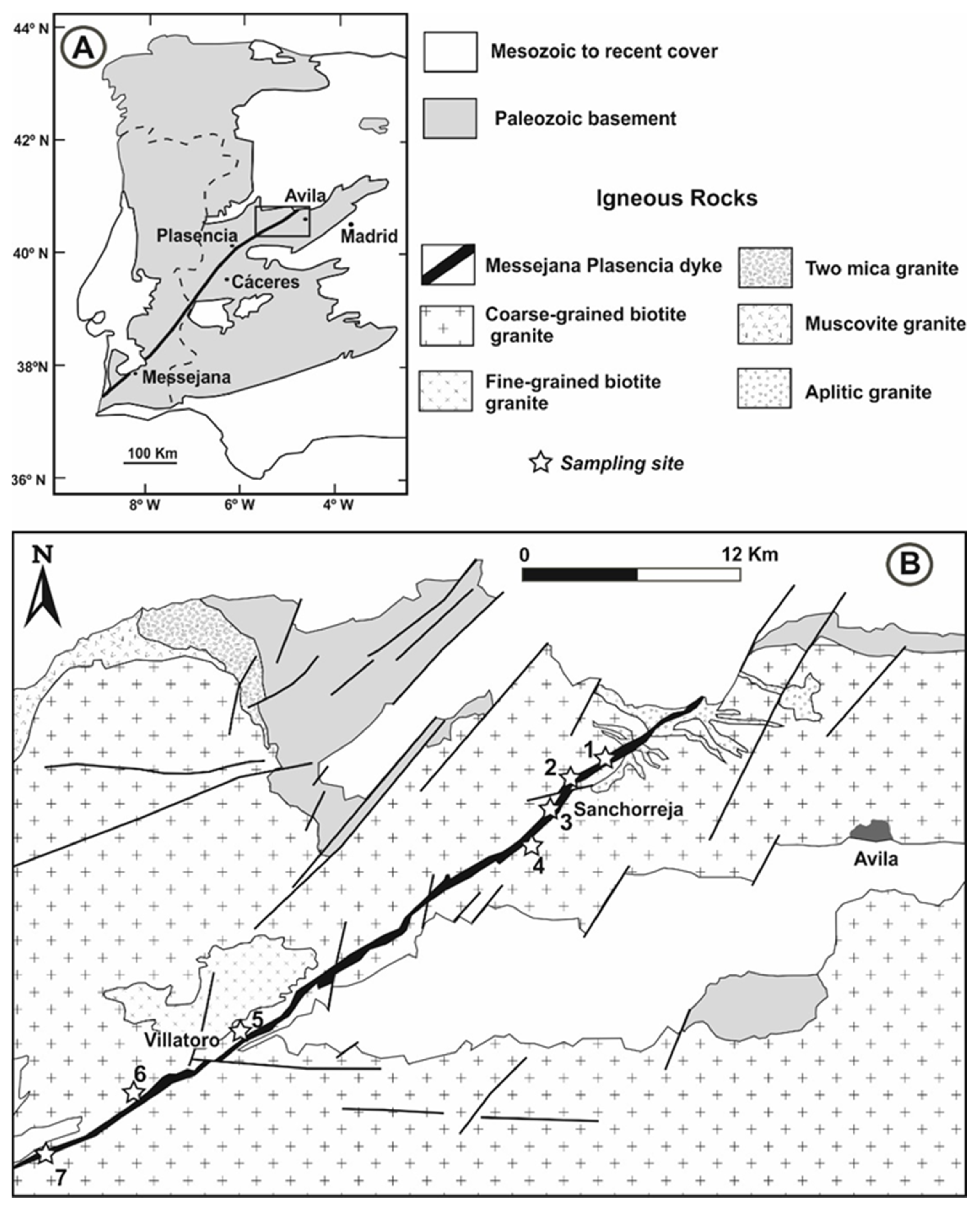
2. Geological Setting
3. Materials and Methods
4. Results
4.1. Outcrop Features and Petrography
4.2. Granophyre Mineral Chemistry
4.2.1. Feldspars
4.2.2. Biotite
4.2.3. Apatite
4.3. Whole-Rock Composition
4.3.1. Major and Trace Elements
4.3.2. Sr–Nd Isotopes
4.3.3. U–Pb Zircon Geochronology
5. Discussion
5.1. Mafic Magma Evolution
5.2. Origin of the Granophyric Melt
5.3. Magma Ascent and Contamination
| AFC model for the MPGD gabbros | ||||||
| 87Sr/86Sr | 143Nd/144Nd | Sr | Nd | Rb | Ba | |
| Initial melt composition | 0.70560 | 0.512443 | 150 | 10.5 | 14.5 | 122 |
| Contaminant composition | 0.71216 | 0.511983 | 248 | 32 | 104 | 1037 |
| Fractionating phases: Cpx (67%), Pl (27%) and Ol (6%) | ||||||
| AFC model for the MPGD granophyres | ||||||
| 87Sr/86Sr | 143Nd/144Nd | Sr | Nd | |||
| Initial melt composition | 0.70636 | 0.512271 | 214 | 20 | ||
| Contaminant composition | 0.71915 | 0.512016 | 96 | 32 | ||
| Fractionating phases: Cpx (50%), Pl (40%) and Opx (10%) | ||||||
| Mineral/mafic magma partition coefficients | ||||||
| Mineral | Element | Kd | Reference | |||
| Clinopyroxene | Sr | 0.1 | [82] | |||
| Clinopyroxene | Nd | 0.38 | [82] | |||
| Clinopyroxene | Rb | 0.015 | [83] | |||
| Clinopyroxene | Ba | 0.005 | [82] | |||
| Plagioclase | Sr | 2 | [84] | |||
| Plagioclase | Nd | 0.3 | [84] | |||
| Plagioclase | Rb | 0.08 | [84] | |||
| Plagioclase | Ba | 0.2 | [84] | |||
| Olivine | Sr | 0.0094 | [83] | |||
| Olivine | Nd | 0.008 | [85] | |||
| Olivine | Rb | 0.0133 | [83] | |||
| Olivine | Ba | 0.01 | [83] | |||
| Orthopyroxene | Sr | 0.0026 | [82] | |||
| Orthopyroxene | Nd | 0.013 | [82] | |||
6. Conclusions
Author Contributions
Funding
Data Availability Statement
Acknowledgments
Conflicts of Interest
References
- Dunn, A.M.; Reynolds, P.H.; Clarke, D.B.; Ugidos, J.M. A comparison of the age and composition of the Sherburne Dyke, Nova Scotia, and the Messejana Dyke, Spain. Can. J. Earth Sci. 1998, 35, 1110–1115. [Google Scholar] [CrossRef]
- de Vicente, G.; Olaiz, A.; Muñoz-Martín, A.; Cunha, P.P. Longest and still longer: The Messejana-Plasencia dyke and its links with later Alpine deformation belt in Iberia. Tectonophysics 2021, 815, 229009. [Google Scholar] [CrossRef]
- Greenough, J.D.; Hodych, J.D. Evidence for lateral magma injection in the Early Mesozoic dykes of eastern North America. In Mafic Dykes and Emplacement Mechanisms; Parker, R.J., Rickwood, P.C., Tucker, D.H., Eds.; Balkema: Rotterdam, The Netherlands, 1990; pp. 35–46. [Google Scholar]
- Dalziel, I.W.D.; Lawver, L.A.; Murphy, J.B. Plumes, orogenesis, and supercontinental fragmentation. Earth Planet. Sci. Lett. 2000, 78, 1–11. [Google Scholar] [CrossRef]
- Torre de Assunçao, C. Sobre uma intrusão doleritica no Antracolitico do Baixo-Alentejo. Bol. Soc. Portu. Cienc. Naturais 1949, 2, 66–74. [Google Scholar]
- Torre de Assunçao, C. Os doleritos pigeoníticos de quimismo pacífico do sul de Portugal. In Boletim do Museu e Laboratório Mineralógico e Geológico da Faculdade de Ciências; Universidade de Lisboa: Lisboa, Portugal, 1951; Volume 19, pp. 109–117. [Google Scholar]
- Cebriá, J.M.; López-Ruiz, J.; Doblas, M.; Martins, L.T.; Munha, J. Geochemistry of the Early Jurassic Messejana-Plasencia dyke (Portugal-Spain); Implications on the Origin of the Central Atlantic Magmatic Province. J. Petrol. 2003, 44, 547–568. [Google Scholar] [CrossRef]
- Villaseca, C.; Orejana, D.; Higueras, P.; Pérez-Soba, C.; García Serrano, J.; Lorenzo, S. The evolution of the subcontinental mantle beneath the Central Iberian Zone: Geochemical tracking of its mafic magmatism from the Neoproterozoic to the Cenozoic. Earth Sci. Rev. 2022, 228, 103997. [Google Scholar] [CrossRef]
- Alibert, C. A Sr-Nd isotope and REE study of Late Triassic dolerites from the Pyrenees (France) and the Messejana dyke (Spain and Portugal). Earth Planet. Sci. Lett. 1985, 73, 81–90. [Google Scholar] [CrossRef]
- Callegaro, S.; Rapaille, C.; Marzoli, A.; Bertrand, H.; Chiaradia, M.; Reisberg, L.; Bellieni, G.; Martins, L.; Madeira, J.; Mata, J.; et al. Enriched mantle source for the Central Atlantic magmatic province: New supporting evidence from southwestern Europe. Lithos 2014, 188, 15–32. [Google Scholar] [CrossRef]
- Schermerhorn, L.J.G.; Priem, H.N.A.; Boelrijk, N.A.I.M.; Hebeda, E.H.; Verdurmen, E.A.T.; Verschure, R.H. Age and origin of the Messejana dolerite fault–dike system (Portugal and Spain) in the light of the opening of the North Atlantic Ocean. J. Geol. 1978, 86, 299–309. [Google Scholar] [CrossRef]
- García de Figuerola, L.C.; Carnicero, A. El extremo noreste del gran dique del Alentejo-Plasencia. Stud. Geol. Salmant. 1973, 6, 73–84. [Google Scholar]
- Dostal, J.; Dunning, M. Geochemical constraints on the origin and evolution of early Mesozoic dikes in Atlantic Canada. Eur. J. Mineral. 1998, 10, 79–93. [Google Scholar] [CrossRef]
- Nomade, S.; Pouclet, A.; Chen, Y. The French Guyana doleritic dykes: Geochemical evidence of three populations and new data for the Jurassic Central Atlantic Magmatic Province. J. Geodyn. 2002, 34, 595–614. [Google Scholar] [CrossRef]
- Kontak, D.J.; De Young, M.Y.D.; Dostal, J. Late-stage crystallization history of the Jurassic North Mountain Basalt, Nova Scotia, Canada. I. Textural and chemical evidence for pervasive development of silicate-liquid immiscibility. Can. Mineral. 2002, 40, 1287–1311. [Google Scholar] [CrossRef]
- Halder, M.; Paul, D.; Yang, S.Y. Origin of silicic rocks of the Deccan Traps continental flood basalt province: Inferences from field observations, petrography, and geochemistry. Geochem. Ger. 2023, 83, 125958. [Google Scholar] [CrossRef]
- Philpotts, A.R. Composition of immiscible liquids in volcanic rocks. Contrib. Mineral. Petrol. 1982, 80, 201–218. [Google Scholar] [CrossRef]
- Andreeva, O.A.; Andreeva, I.A.; Yarmolyuk, V.V.; Ji, J.Q.; Zhou, X.; Borisovskii, S.E. Silicate Liquid Immiscibility as a Result of Fenner-Type Crystal Fractionation of Wangtian’e Tholeiitic Melts, Northeast China. Petrology 2020, 28, 357–373. [Google Scholar] [CrossRef]
- Martínez-Catalán, J.R. The Central Iberian arc, an orocline centered in the Iberian Massif and some implications for the Variscan belt. Int. J. Earth Sci. 2012, 101, 1299–1314. [Google Scholar] [CrossRef]
- Kroner, U.; Romer, R.L. Two plates—Many subduction zones: The Variscan orogeny reconsidered. Gondwana Res. 2013, 24, 298–329. [Google Scholar] [CrossRef]
- Orejana, D.; Villaseca, C.; Kristoffersen, M. Geochemistry and geochronology of mafic rocks from the Spanish Central System: Constraints on the mantle evolution beneath central Spain. Geosci. Front. 2020, 11, 1651–1667. [Google Scholar] [CrossRef]
- Scarrow, J.H.; Molina, J.F.; Bea, F.; Montero, P.; Vaughan, A.P.M. Lamprophyre dikes as tectonic markers of late orogenic transtension timing and kinematics: A case study from the Central Iberian Zone. Tectonics 2011, 30, TC4007. [Google Scholar] [CrossRef]
- Oliveira, A.J.T.; Martins, H.C.B.; da Silva, H.M.S.M. Permo-Carboniferous hypabyssal magmatism in northern Portugal: The case of the Lamas de Olo microgranite and lamprophyre dykes. Iber. J. Geol. 2022, 48, 1–28. [Google Scholar] [CrossRef]
- Sebai, A.; Féraud, G.; Bertrand, H.; Hanes, J. 40Ar/39Ar dating and geochemistry of tholeiitic magmatism related to the early opening of the Central Atlantic rift. Earth Planet. Sci. Lett. 1991, 104, 455–472. [Google Scholar] [CrossRef]
- Osete, M.L.; Palencia Ortas, A. Iberian palaeomagnetic poles for the last 300 Ma. Fis. Tierra 2006, 18, 157–181. [Google Scholar]
- García de Figuerola, L.C.; Corretge, L.G.; Bea, F. El dique de Alentejo-Plasencia y haces de diques básicos de Extremadura. Bol. Geol. Min. Esp. 1974, 85, 308–337. [Google Scholar]
- Bertrand, H.; Millot, G. Le magmatisme tholéitique continental de la marge Ibérique, précurseur de l’overture de l’Atlantique Central: Les dolérites du dyke de Messejana–Plasencia (Portugal–Espagne). C. R. Geosci. 1987, 304, 215–220. [Google Scholar]
- Martins, L.T.; Cebriá, J.M.; Doblas, M.; López-Ruiz, J.; Munhá, J. Petrologia e geoquímica do dique de Messejana. Mem. Mus. Lab. Geol. Mineral. Porto 1995, 4, 747–750. [Google Scholar]
- Andonaegui, P.; Villaseca, C.; López García, J.A. Caracterización de los minerales del dique gabroideo de Messejana-Plasencia en su sector nor-oriental. Geogaceta 2005, 38, 219–222. [Google Scholar]
- Dahlquist, J.A.; Galindo, C.; Morales Camera, M.M.; Moreno, J.A.; Alasino, P.H.; Basei, M.A.S.; Macchioli Grande, M. A combined zircon Hf isotope and whole rock Nd and Sr isotopes study of Carboniferous A-type granites, Sierras Pampeanas of Argentina. J. S. Am. Earth Sci. 2020, 100, 102545. [Google Scholar] [CrossRef]
- Black, L.P.; Kamo, S.L.; Allen, C.M.; Aleinikoff, J.N.; Davis, D.W.; Korsch, R.J.; Foudoulis, C. TEMORA 1: A new zircon standard for Phanerozoic U–Pb geochronology. Chem. Geol. 2003, 200, 155–170. [Google Scholar] [CrossRef]
- Black, L.P.; Kamo, S.L.; Allen, C.M.; Davis, D.W.; Aleinikoff, J.N.; Valley, J.W.; Mundil, R.; Campbell, I.H.; Korsch, R.J.; Williams, I.S.; et al. Improved Pb/U microprobe geochronology by the monitoring of a trace-element-related matrix effect; SHRIMP, ID-TIMS, ELA-ICP-MS and oxygen isotope documentation for a series of zircon standards. Chem. Geol. 2004, 205, 115–140. [Google Scholar] [CrossRef]
- Ludwig, K.R. ISOPLOT/Ex, version 3. A geochronological toolkit for Microsoft Excel. Berkeley Geochr. Cent. Spec. Pub. 2003, 4, 1–71. [Google Scholar]
- Whitney, D.L.; Evans, B.W. Abbreviations for names of rock-forming minerals. Am. Mineral. 2010, 95, 185–187. [Google Scholar] [CrossRef]
- Rossi, P.; Chevremont, P. Classification des associations magmatiques granitoides. Geochronique 1987, 21, 14–18. [Google Scholar]
- Nachit, H.; Razafimahefa, N.; Stussi, J.M.; Carron, J.P. Biotite chemical-compositions and magmatic typology of the granitoids. C. R. Geosci. 1985, 301, 813–817. [Google Scholar]
- Rollinson, H.R. Using Geochemical Data: Evaluation, Presentation, Interpretation; Longman Scientific & Technical: New York, NY, USA, 1993; 352p. [Google Scholar]
- Brandebourger, E. Les Granitoides Hercyniens Tardifs de la Sierra de Guadarrama (Système Central, Espagne): Pétrographie et Geochimie. Ph.D. Thesis, Université de Lorraine, Metz, France, 1984; 209p. [Google Scholar]
- Casillas, R. Las Asociaciones Plutónicas Tardihercínicas del Sector Occidental de la Sierra de Guadarrama, Sistema Central Español, (Las Navas del Marqués–San Martín de Valdeiglesias). Petrología, Geoquímica, Génesis y Evolución. Ph.D. Thesis, Universidad Complutense de Madrid, Madrid, Spain, 1989; 316p. [Google Scholar]
- Villaseca, C.; Barbero, L.; Rogers, G. Crustal origin of Hercynian peraluminous granitic batholiths of central Spain: Petrological, geochemical and isotopic (Sr,Nd) arguments. Lithos 1998, 43, 55–79. [Google Scholar] [CrossRef]
- Sun, S.S.; McDonough, W.F. Chemical and isotopic systematics of oceanic basalts; implications for mantle composition and processes. In Magmatism in Ocean Basins; Saunders, A.D., Norrey, M.J., Eds.; Geological Society Special Publication: Oxford, UK, 1989; Volume 42, pp. 313–345. [Google Scholar]
- McDonough, W.F.; Sun, S.S. The composition of the Earth. Chem. Geol. 1995, 120, 223–253. [Google Scholar] [CrossRef]
- Villaseca, C.; Merino Martínez, E.; Orejana, D.; Andersen, T.; Belousova, E.A. Zircon Hf signatures from granitic orthogneisses of the Spanish Central System: Significance and sources of the Cambro-Ordovician magmatism in the Iberian Variscan Belt. Gondwana Res. 2016, 34, 60–83. [Google Scholar] [CrossRef]
- Orejana, D.; Villaseca, C.; Elburg, M.A.; Merino-Martínez, E.; Serrano, J.G. Nature and evolution of the lower crust under central Spain: Inferences from granulite xenoliths (Calatrava Volcanic Field-Spanish central system). Geosci. Front. 2023, 14, 101525. [Google Scholar] [CrossRef]
- Orejana, D.; Villaseca, C.; Valverde-Vaquero, P.; Belousova, E.A.; Armstrong, R.A. U–Pb geochronology and zircon composition of late Variscan S- and I-type granitoids from the Spanish Central System batholith. Int. J. Earth Sci. 2012, 101, 1789–1815. [Google Scholar] [CrossRef]
- Orejana, D.; Villaseca, C.; Armstrong, R.A.; Jeffries, T.E. Geochronology and trace element chemistry of zircon and garnet from granulite xenoliths: Constraints on the tectonothermal evolution of the lower crust under central Spain. Lithos 2011, 124, 103–116. [Google Scholar] [CrossRef]
- Fernández Suárez, J.; Arenas, R.; Jeffries, T.E.; Whitehouse, M.J.; Villaseca, C. A U–Pb study of zircons from a lower crustal granulite xenolith of the Spanish Central system: A record of Iberian lithospheric evolution from the Neoproterozoic to the Triassic. J. Geol. 2006, 114, 471–483. [Google Scholar] [CrossRef]
- Cox, K.G.; MacDonald, R.; Hornung, G. Geochemical and petrographic provinces in the Karroo basalts of southern Africa. Am. Mineral. 1967, 52, 1451–1474. [Google Scholar]
- Thy, P.; Lesher, C.E.; Nielsen, T.F.D.; Brooks, C.K. Experimental constraints on the Skaergaard liquid line of descent. Lithos 2006, 92, 154–180. [Google Scholar] [CrossRef]
- Villiger, S.; Ulmer, P.; Müntener, O. Equilibrium and fractional crystallization experiments at 0.7 GPa: The effect of pressure on phase relations and liquid compositions of tholeiitic magmas. J. Petrol. 2007, 48, 159–184. [Google Scholar] [CrossRef]
- Sisson, T.W.; Ratajeski, K.; Hankins, W.B.; Glazner, A.F. Voluminous granitic magmas from common basaltic sources. Contrib. Mineral. Petrol. 2005, 148, 635–661. [Google Scholar] [CrossRef]
- Hotz, P.E. Petrology of granophyre in diabase near Dillsburg, Pennsylvania. Geol. Soc. Am. Bull. 1953, 64, 675–704. [Google Scholar] [CrossRef]
- Marsh, B.D. Solidification fronts and magmatic evolution. Mineral. Mag. 1996, 60, 5–40. [Google Scholar] [CrossRef]
- White, C.M. The graveyard point intrusion: An example of extreme differentiation of Snake River Plain basalt in a shallow crustal pluton. J. Petrol. 2007, 48, 303–325. [Google Scholar] [CrossRef]
- Johannes, E.; Holtz, F. Petrogenesis and Experimental Petrology of Granitic Rocks. Minerals, Rocks and Mountains; Springer: Berlin, Germany, 1996; 335p. [Google Scholar]
- Winter, J.D. An Introduction to Igneous and Metamorphic Petrology, 1st ed.; Prentince Hall: Upper Saddle River, NJ, USA, 2001; 697p. [Google Scholar]
- Charlier, B.; Namur, O.; Toplis, M.J.; Schiano, P.; Cluzel, N.; Higgins, M.D.; Vander Auwera, J. Large-scale silicate liquid immiscibility during differentiation of tholeiitic basalt to granite and the origin of the Daly gap. Geology 2011, 39, 907–910. [Google Scholar] [CrossRef]
- Geist, D.; Howard, K.A.; Larson, P. The Generation of Oceanic Rhyolites by Crystal Fractionation—The Basalt-Rhyolite Association at Volcan-Alcedo, Galapagos-Archipelago. J. Petrol. 1995, 36, 965–982. [Google Scholar] [CrossRef]
- Peccerillo, A. Relationships between Mafic and Peralkaline Silicic Magmatism in Continental Rift Settings: A Petrological, Geochemical and Isotopic Study of the Gedemsa Volcano, Central Ethiopian Rift. J. Petrol. 2003, 44, 2003–2032. [Google Scholar] [CrossRef]
- Dufek, J.; Bachmann, O. Quantum magmatism: Magmatic compositional gaps generated by melt-crystal dynamics. Geology 2010, 38, 687–690. [Google Scholar] [CrossRef]
- McBirney, A.R. Differentiation of the Skaergaard intrusion. Nature 1975, 253, 691–694. [Google Scholar] [CrossRef]
- Jakobsen, J.K.; Veksler, I.V.; Tegner, C.; Brooks, C.K. Immiscible iron- and silica-rich melts in basalt petrogenesis documented in the Skaergaard intrusion. Geology 2005, 33, 885–888. [Google Scholar] [CrossRef]
- Ripley, E.M.; Severson, M.J.; Hauck, S.A. Evidence for sulfide and Fe-Ti-P-rich liquid immiscibility in the Duluth Complex, Minnesota. Econ. Geol. Bull. Soc. 1998, 93, 1052–1062. [Google Scholar] [CrossRef]
- Namur, O.; Charlier, B.; Holness, M.B. Dual origin of Fe-Ti-P gabbros by immiscibility and fractional crystallization of evolved tholeiitic basalts in the Sept Iles layered intrusion. Lithos 2012, 154, 100–114. [Google Scholar] [CrossRef]
- VanTongeren, J.A.; Mathez, E.A. Large-scale liquid immiscibility at the top of the Bushveld Complex, South Africa. Geology 2012, 40, 491–494. [Google Scholar] [CrossRef]
- Charlier, B.; Namur, O.; Grove, T.L. Compositional and kinetic controls on liquid immiscibility in ferrobasalt-rhyolite volcanic and plutonic series. Geochim. Cosmochim. Acta 2013, 113, 79–93. [Google Scholar] [CrossRef]
- Roedder, E.W. Low temperature liquid immiscibility field in the system K2O–FeO–Al2O3–SiO2. Am. Mineral. 1951, 36, 282–286. [Google Scholar]
- Veksler, I.V.; Dorfman, A.M.; Danyushevsky, L.V.; Jakobsen, J.K.; Dingwell, D.B. Immiscible silicate liquid partition coefficients: Implications for crystal-melt element partitioning and basalt petrogenesis. Contrib. Mineral. Petrol. 2006, 152, 685–702. [Google Scholar] [CrossRef]
- Villaseca, C.; Downes, H.; Pin, C.; Barbero, L. Nature and composition of the lower continental crust in central Spain and the granulite-granite linkage: Inferences from granulitic xenoliths. J. Petrol. 1999, 40, 1465–1496. [Google Scholar] [CrossRef]
- Grieco, G.; Ferrario, A.; von Quadt, A.; Koeppel, V.; Mathez, E.A. The zircon-bearing chromitites of the phlogopite peridotite of Finero (Ivrea zone, southern Alps): Evidence and geochronology of a metasomatized mantle slab. J. Petrol. 2001, 42, 89–101. [Google Scholar] [CrossRef]
- Liu, Y.; Gao, S.; Hu, Z.; Gao, C.; Zong, K.; Wang, D. Continental and oceanic crust recycling-induced melt-peridotite interactions in the Trans-North China Orogen: U–Pb dating, Hf isotopes and trace elements in zircons from mantle xenoliths. J. Petrol. 2010, 51, 537–571. [Google Scholar] [CrossRef]
- González-Jiménez, J.M.; Marchesi, C.; Griffin, W.L.; Gervilla, F.; Belousova, E.A.; Garrido, C.J.; Romero, R.; Talavera, C.; Leisen, M.; O’Reilly, S.Y.; et al. Zircon recycling and crystallization during formation of chromite- and Ni-arsenide ores in the subcontinental lithospheric mantle (Serranía de Ronda, Spain). Ore Geol. Rev. 2017, 90, 193–209. [Google Scholar] [CrossRef]
- Gutiérrez-Alonso, G.; Murphy, J.B.; Fernández-Suárez, J.; Weil, A.B.; Franco, M.P.; Gonzalo, J.C. Lithospheric delamination in the core of Pangea: Sm–Nd insights from the Iberian mantle. Geology 2011, 39, 155–158. [Google Scholar] [CrossRef]
- DePaolo, D.J. Trace element and isotopic effects of combined wallrock assimilation and fractional crystallization. Earth Planet. Sci. Lett. 1981, 53, 189–202. [Google Scholar] [CrossRef]
- Wenner, D.; Taylor, H. Oxygen and hydrogen isotope studies of a precambrian granite-rhyolite terrane, St-Francois mountains, southeastern Missouri. Geol. Soc. Am. Bull. 1976, 87, 1587–1598. [Google Scholar] [CrossRef]
- Walraven, F.; Strydom, J.H.; Strydom, N. Rb–Sr open-system behaviour and its application as a pathfinder for Sn mineralisation in granites of the Bushveld Complex, South Africa. J. Geochem. Expl. 1990, 37, 333–350. [Google Scholar] [CrossRef]
- Brantley, S.L.; Chesley, J.T.; Stillings, L.L. Isotopic ratios and release rates of strontium from weathering feldspars. Geochim. Cosmochim. Acta 1998, 62, 1493–1500. [Google Scholar] [CrossRef]
- Ma, Y.; Liu, C. Sr isotope evolution during chemical weathering of granites—Impact of relative weathering rates of minerals. Sci. China (Earth Sci.) 2001, 44, 726–734. [Google Scholar] [CrossRef]
- Kaur, P.; Chaudhri, N.; Hofmann, A.W.; Raczek, I.; Okrusch, M.; Skora, S.; Baumgartner, L.P. Two-Stage, extreme albitization of A-type granites from Rajasthan, NW India. J. Petrol. 2012, 53, 919–948. [Google Scholar] [CrossRef]
- Ubanell, A.G.; Garzón, G.; de la Peña, J.A.; Bustillo, A.; Martil, R. Estudio de procesos de alteración hidrotermal en rocas graníticas y sedimentarias (provincia de Ávila). Est. Geol. 1978, 34, 151–160. [Google Scholar]
- Parsapoor, A.; Khalili, M.; Maghami, M. Discrimination between mineralized and unmineralized alteration zones using primary geochemical haloes in the Darreh-Zar porphyry copper deposit in Kerman, southeastern Iran. J. Afr. Earth Sci. 2017, 132, 109–126. [Google Scholar] [CrossRef]
- Irving, A.J.; Frey, F.A. Trace element abundances in megacrysts and their host basalts: Constraints on partition coefficients and megacryst genesis. Geochim. Cosmochim. Acta 1984, 48, 1201–1221. [Google Scholar] [CrossRef]
- Philpotts, J.A.; Schnetzler, C.C. Phenocryst-matrix partition coefficients for K, Rb, Sr and Ba, with applications to anorthosite and basalt genesis. Geochim. Cosmochim. Acta 1970, 34, 307–322. [Google Scholar] [CrossRef]
- Bindeman, I.N.; Davis, A.M.; Drake, M.J. Ion Microprobe Study of Plagioclase-Basalt Partition Experiments at Natural Con-centration Levels of Trace Elements. Geochim. Cosmochim. Acta 1998, 62, 1175–1193. [Google Scholar] [CrossRef]
- Paster, T.P.; Schauwecker, D.S.; Haskin, L.A. The behavior of some trace elements during solidification of the Skaergaard layered series. Geochim. Cosmochim. Acta 1974, 38, 1549–1577. [Google Scholar] [CrossRef]
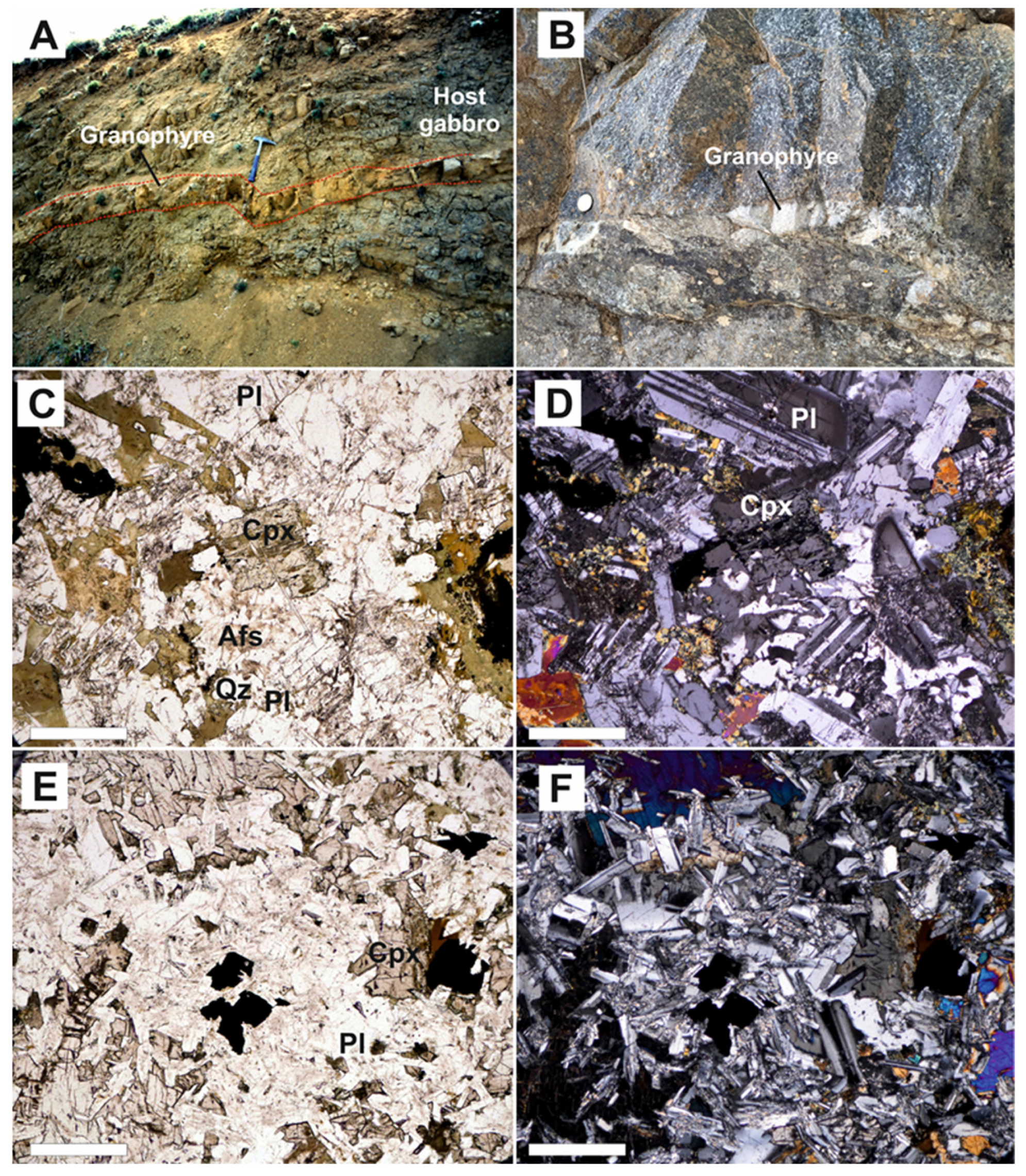
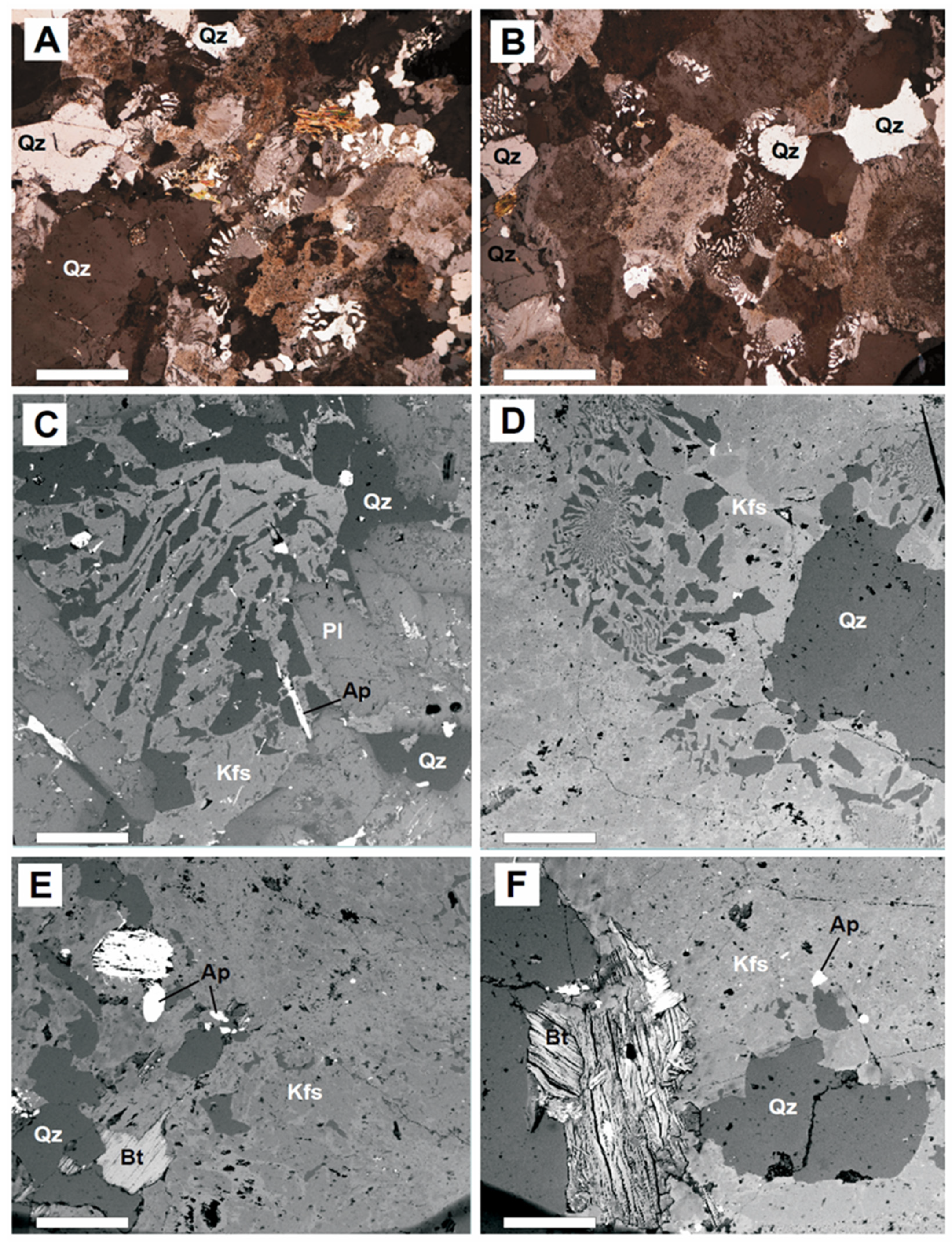
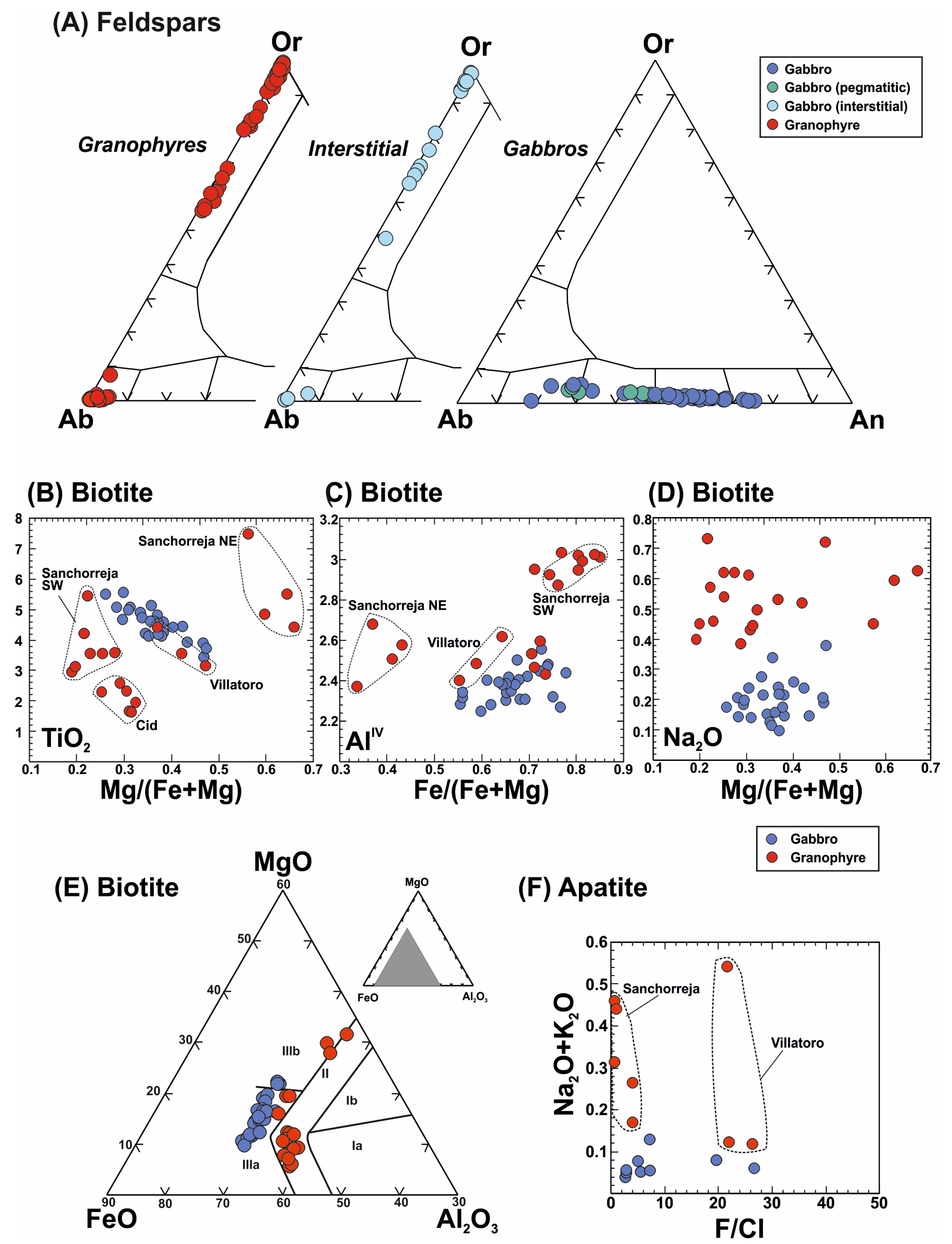
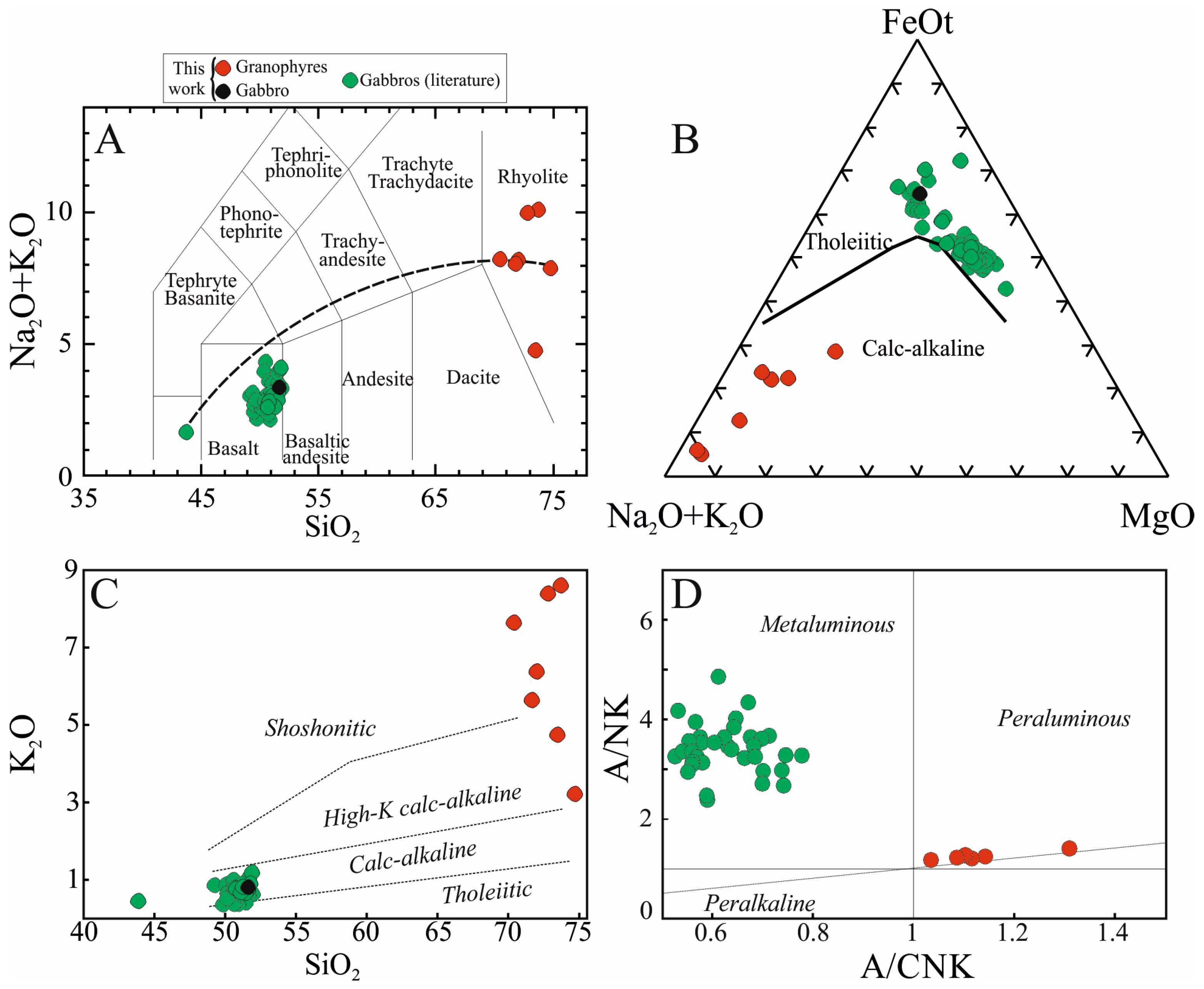

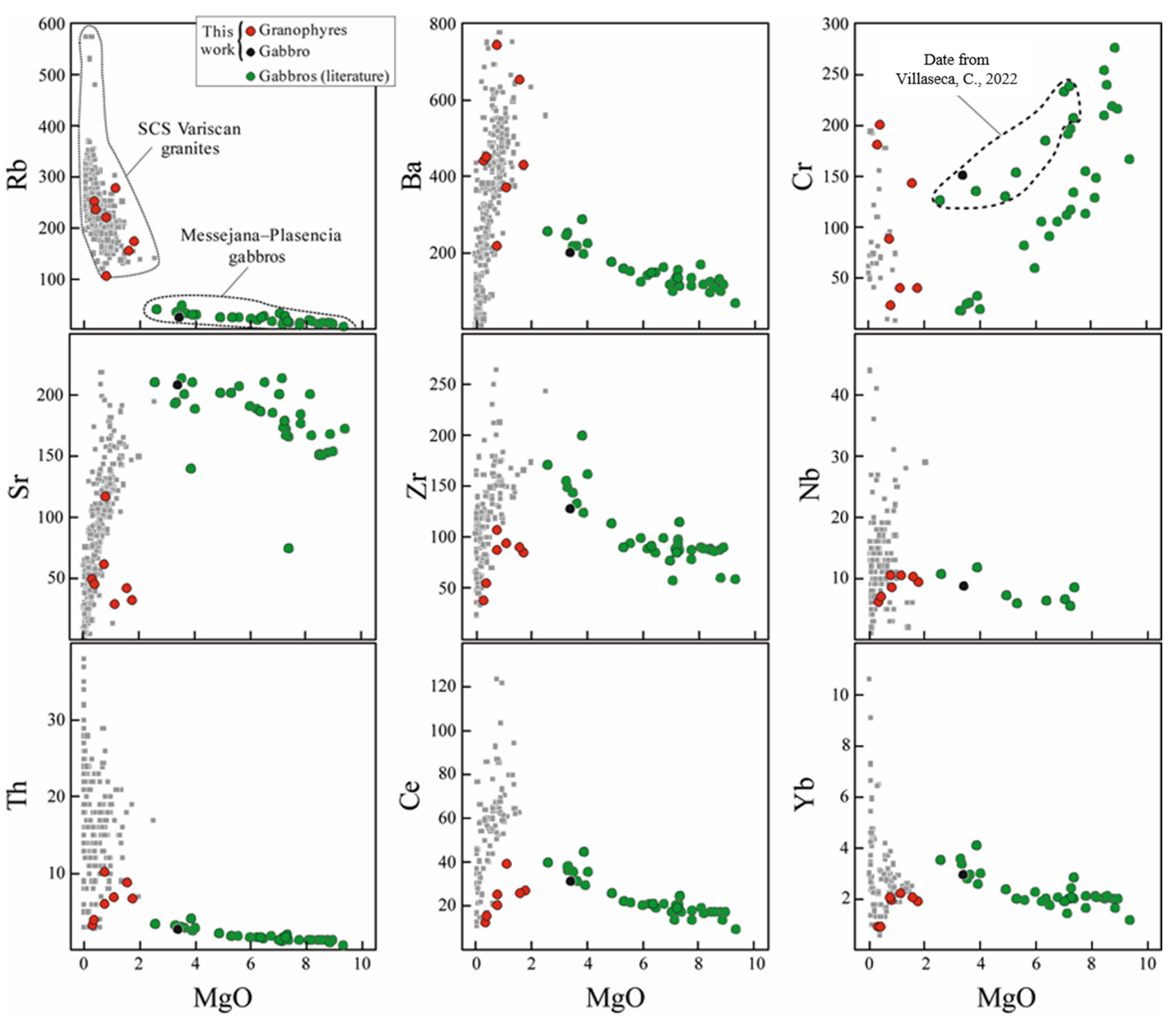

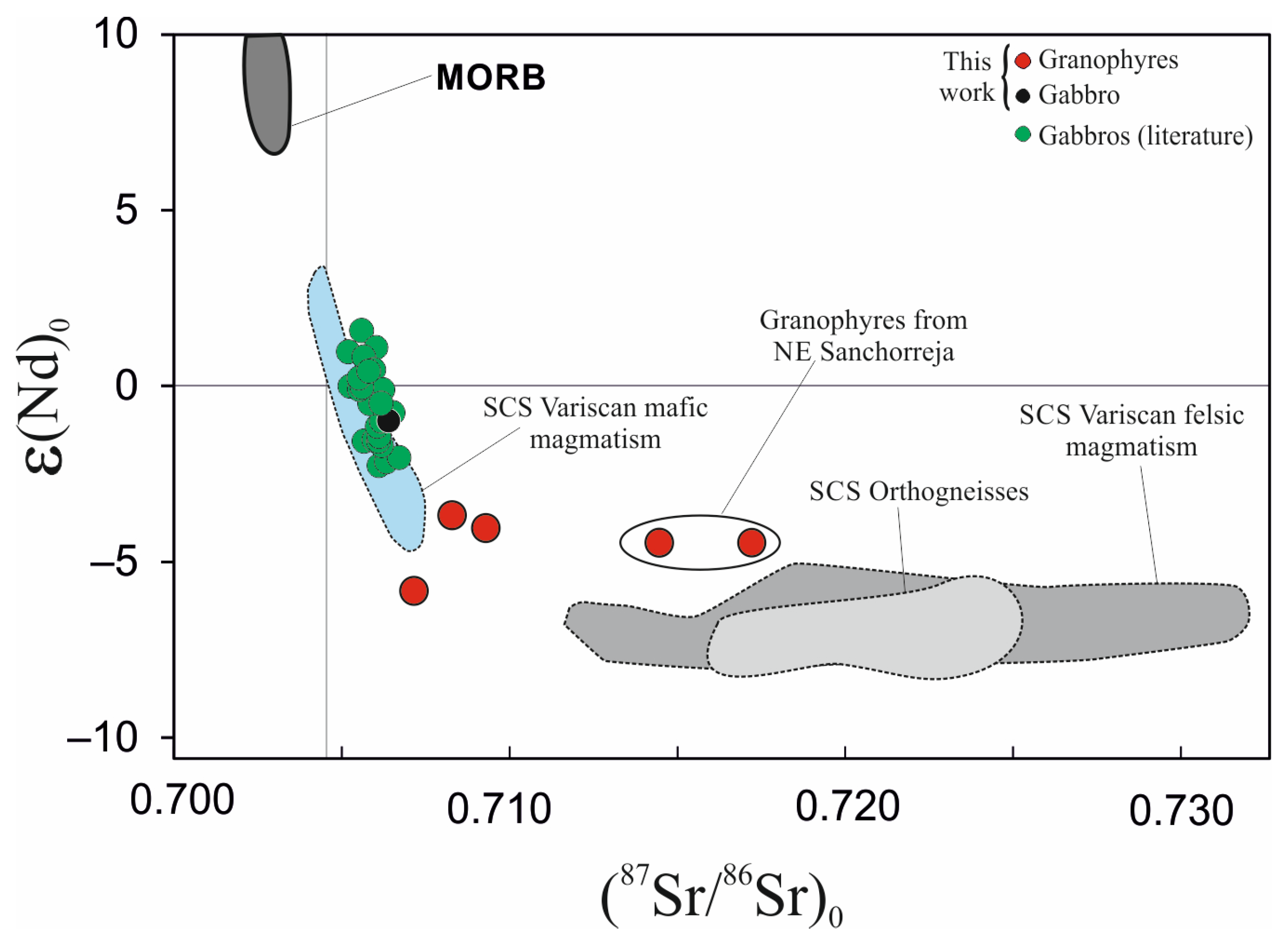
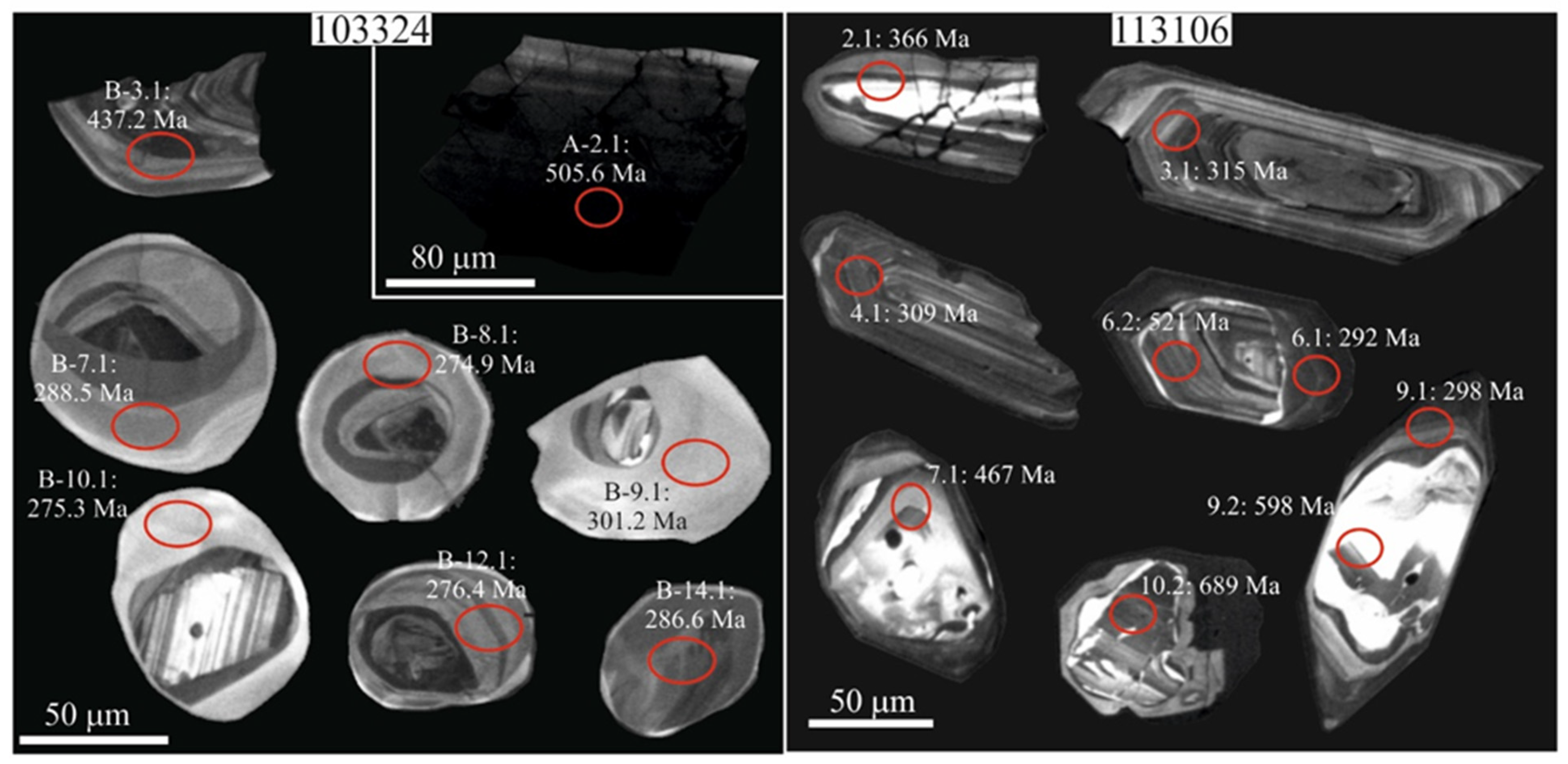
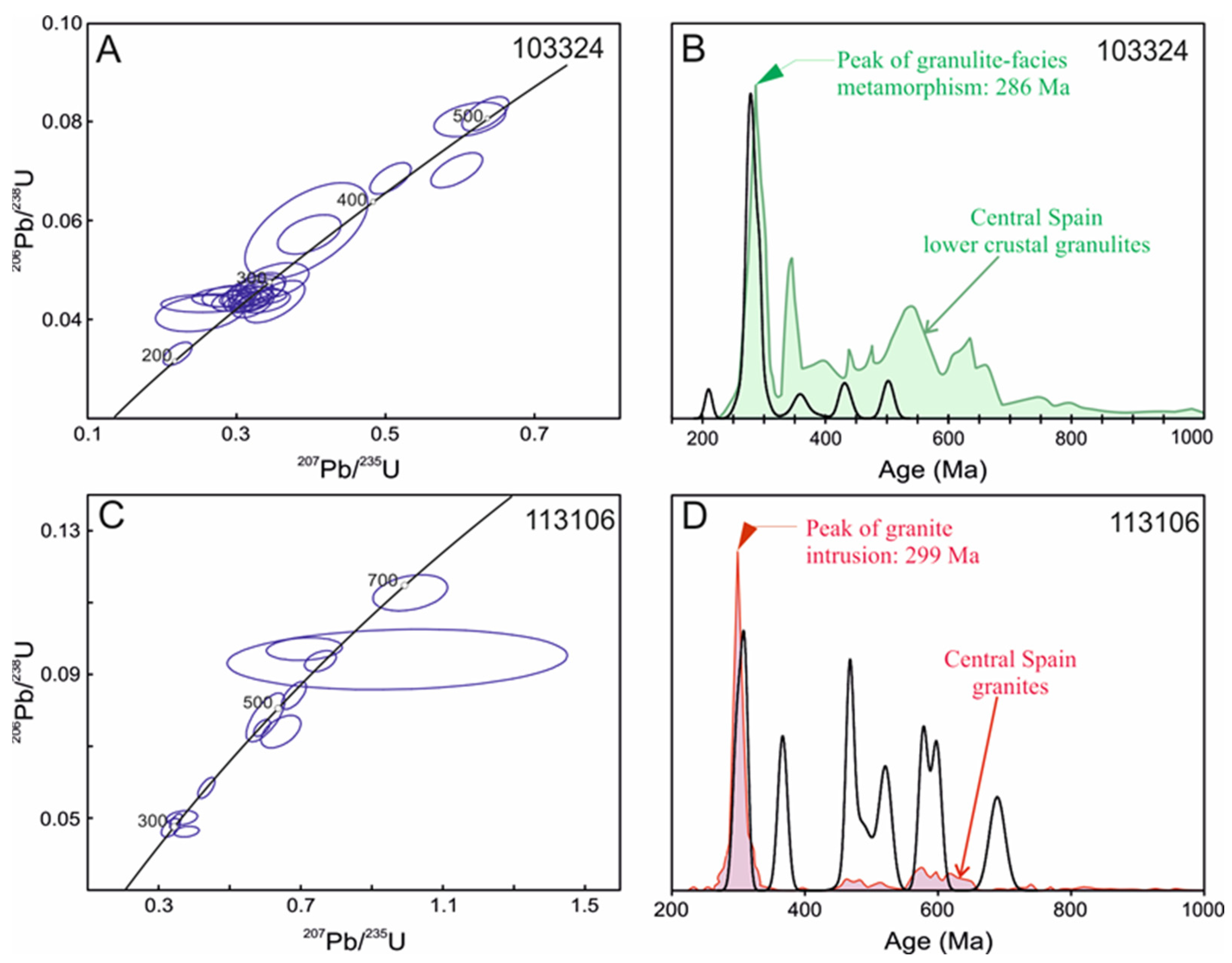
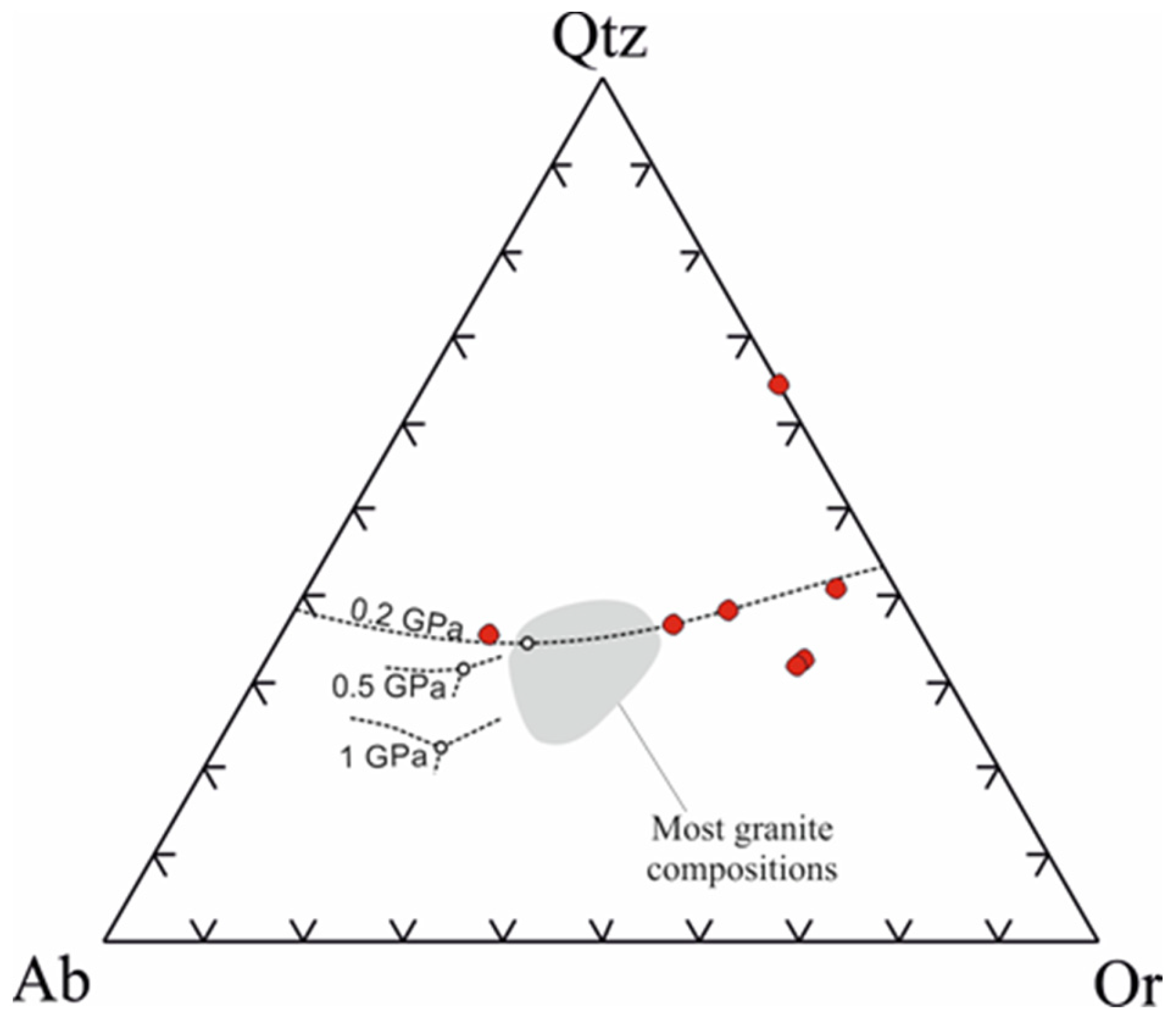
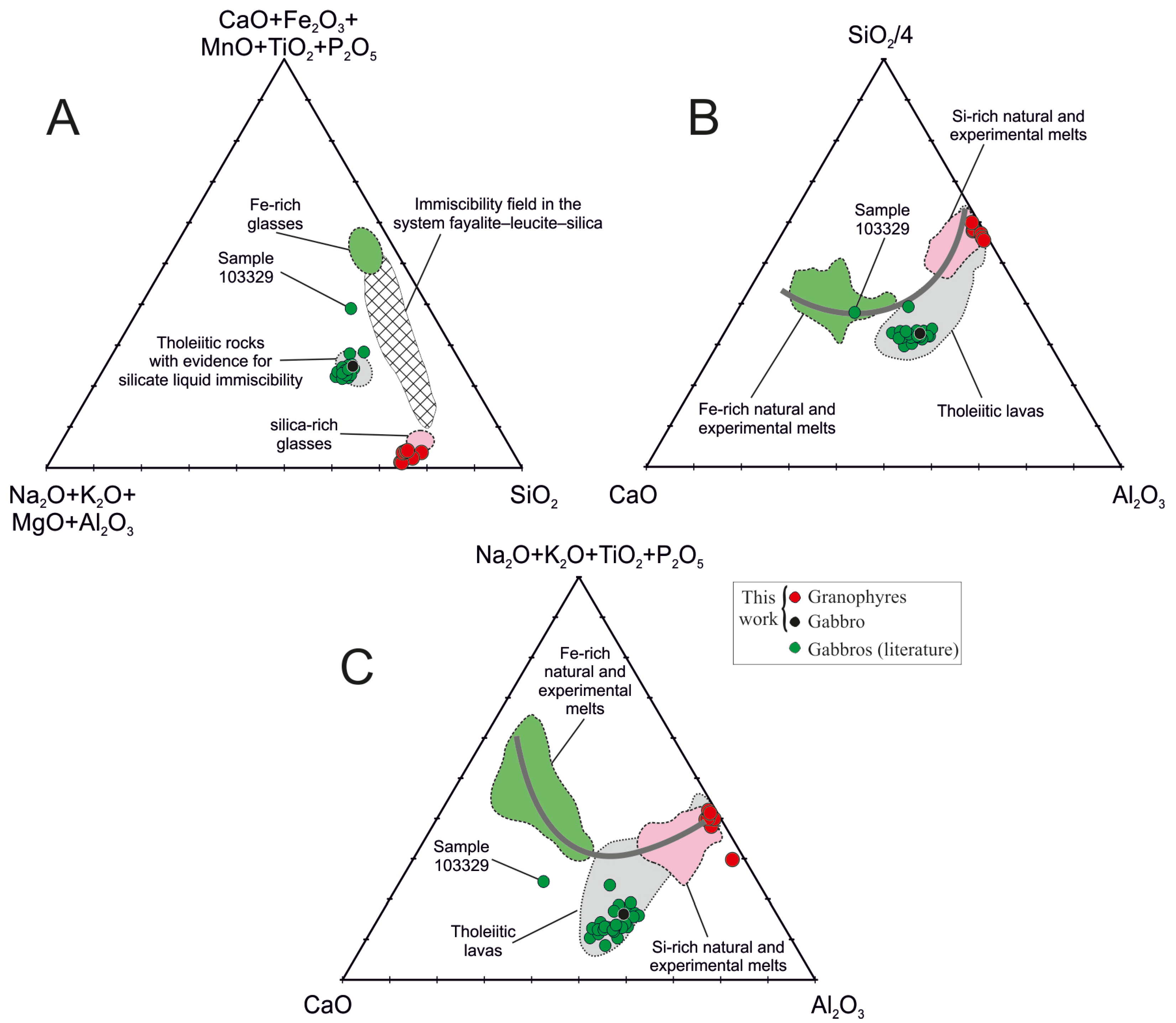
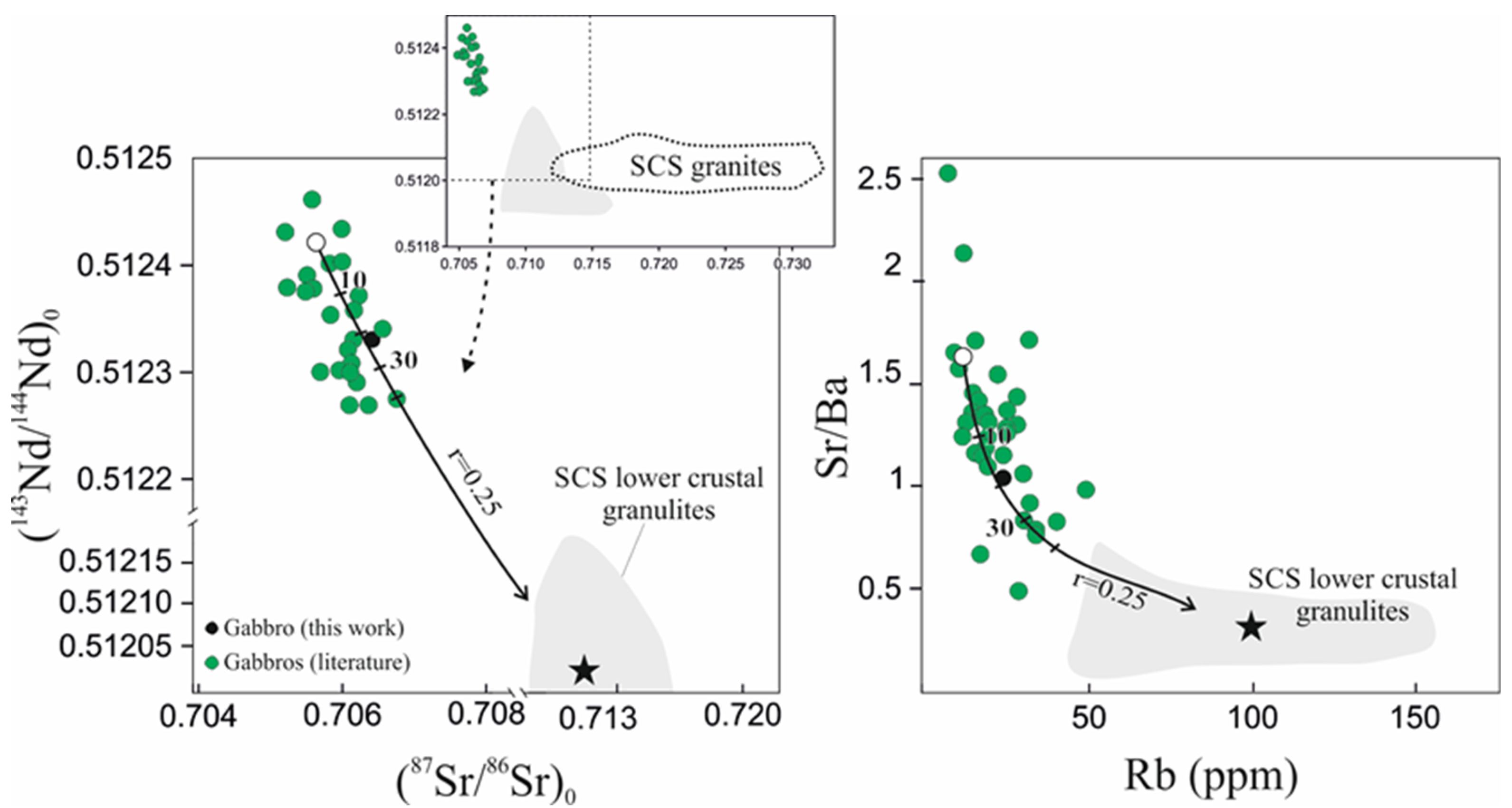
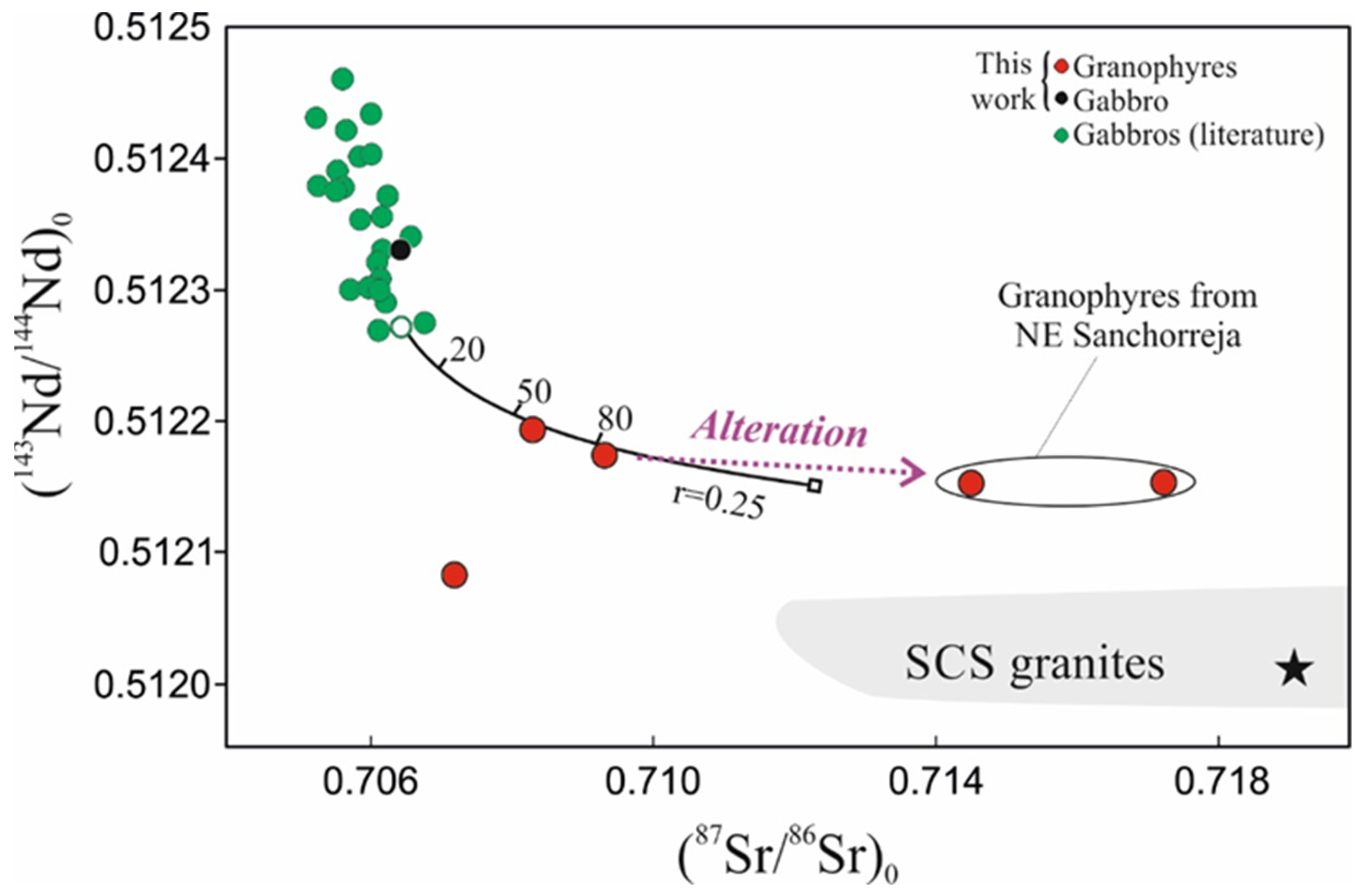
| Sample | 103324 | 103324 | 103324 | 103324 | 103317 | 103317 | 103317 | 103327 | 103327 | 103327 | 103327 | 103309 | 104367 |
|---|---|---|---|---|---|---|---|---|---|---|---|---|---|
| Analysis | 48 | 37 | 39 | 43 | 28 | 42 | 45 | 33 | 35 | 2 | 19 | 74 | 81 |
| Rock | Gb | Gb | Gb | Gb | Gb | Gb | Gb | Gb peg | Gb peg | Gb peg | Gb peg | Gb | Grn |
| Mineral | Kfs | Kfs | Pl | Pl | Pl | Pl | Pl | Pl | Pl | Pl | Kfs | Pl | Pl |
| Location | interst | interst | rim | core | interst | interst | interst | ||||||
| Outcrop | 7 | 7 | 7 | 7 | 6 | 6 | 6 | 7 | 7 | 7 | 7 | 1 | 6 |
| SiO2 | 64.99 | 62.94 | 59.96 | 52.63 | 49.46 | 50.19 | 66.27 | 66.83 | 55.51 | 61.61 | 63.92 | 50.52 | 67.52 |
| TiO2 | 0.01 | 0.08 | 0.02 | 0.11 | 0.01 | 0.04 | 0.00 | 0.00 | 0.06 | 0.04 | 0.08 | 0.03 | 0.03 |
| Al2O3 | 18.73 | 18.15 | 23.44 | 28.75 | 30.18 | 29.56 | 20.19 | 19.67 | 27.29 | 23.72 | 18.97 | 30.90 | 19.77 |
| FeOt | 0.08 | 0.03 | 0.19 | 0.47 | 0.74 | 0.78 | 0.12 | 0.00 | 0.71 | 0.35 | 0.13 | 0.65 | 0.04 |
| MnO | 0.04 | 0.00 | 0.00 | 0.00 | 0.00 | 0.06 | 0.03 | 0.00 | 0.00 | 0.00 | 0.00 | 0.00 | 0.01 |
| MgO | 0.02 | 0.00 | 0.00 | 0.04 | 0.13 | 0.20 | 0.06 | 0.00 | 0.02 | 0.01 | 0.00 | 0.02 | 0.00 |
| CaO | 0.24 | 0.05 | 5.74 | 11.53 | 16.74 | 14.92 | 1.48 | 0.54 | 10.43 | 5.65 | 0.36 | 14.73 | 0.09 |
| Na2O | 3.25 | 0.68 | 8.32 | 4.85 | 3.00 | 3.83 | 11.01 | 11.42 | 5.75 | 8.00 | 2.54 | 3.08 | 12.02 |
| K2O | 12.20 | 15.95 | 0.77 | 0.31 | 0.12 | 0.22 | 0.42 | 0.04 | 0.43 | 0.82 | 12.56 | 0.16 | 0.03 |
| Total | 99.57 | 97.88 | 98.45 | 98.73 | 100.56 | 100.16 | 99.63 | 98.50 | 100.27 | 100.25 | 98.57 | 100.15 | 99.75 |
| Cations calculated based on 8 O | |||||||||||||
| Si | 2.980 | 2.979 | 2.721 | 2.420 | 2.273 | 2.312 | 2.929 | 2.968 | 2.509 | 2.740 | 2.953 | 2.307 | 2.968 |
| Ti | 0.000 | 0.003 | 0.001 | 0.004 | 0.000 | 0.001 | 0.000 | 0.000 | 0.002 | 0.001 | 0.003 | 0.001 | 0.001 |
| Al | 1.013 | 1.013 | 1.254 | 1.559 | 1.635 | 1.605 | 1.052 | 1.030 | 1.454 | 1.244 | 1.050 | 1.664 | 1.024 |
| Fe3+ | 0.003 | 0.001 | 0.006 | 0.016 | 0.026 | 0.027 | 0.004 | 0.000 | 0.024 | 0.012 | 0.004 | 0.022 | 0.001 |
| Mg | 0.001 | 0.000 | 0.000 | 0.002 | 0.009 | 0.014 | 0.004 | 0.000 | 0.002 | 0.001 | 0.000 | 0.001 | 0.000 |
| Mn | 0.002 | 0.000 | 0.000 | 0.000 | 0.000 | 0.002 | 0.001 | 0.000 | 0.000 | 0.000 | 0.000 | 0.000 | 0.001 |
| Ca | 0.012 | 0.003 | 0.279 | 0.568 | 0.824 | 0.736 | 0.070 | 0.026 | 0.505 | 0.269 | 0.018 | 0.721 | 0.004 |
| Na | 0.289 | 0.063 | 0.732 | 0.432 | 0.267 | 0.342 | 0.943 | 0.983 | 0.504 | 0.690 | 0.231 | 0.273 | 1.024 |
| K | 0.714 | 0.963 | 0.044 | 0.018 | 0.007 | 0.013 | 0.024 | 0.002 | 0.025 | 0.047 | 0.752 | 0.009 | 0.002 |
| Suma cat. | 5.013 | 5.024 | 5.038 | 5.020 | 5.041 | 5.053 | 5.027 | 5.009 | 5.024 | 5.003 | 5.010 | 4.998 | 5.025 |
| An | 1.18 | 0.27 | 26.44 | 55.78 | 74.90 | 67.12 | 6.77 | 2.52 | 48.85 | 26.79 | 1.80 | 71.88 | 0.41 |
| Ab | 28.48 | 6.10 | 69.36 | 42.46 | 24.26 | 31.22 | 90.86 | 97.26 | 48.75 | 68.59 | 23.09 | 27.22 | 99.43 |
| Or | 70.34 | 93.64 | 4.20 | 1.77 | 0.66 | 1.19 | 2.29 | 0.22 | 2.39 | 4.63 | 75.11 | 0.90 | 0.16 |
| Sample | 103311 | 103311 | 103326 | 103326 | 106284 | 106284 | 106292 | 106292 | 113105 | 113105 | 113106 | 113106 | |
| Analysis | 32 | 60 | 11 | 13 | 95 | 97 | 77 | 81 | 30 | 31 | 50 | 57 | |
| Rock | Grn | Grn | Grn | Grn | Grn | Grn | Grn | Grn | Grn | Grn | Grn | Grn | |
| Mineral | Pl | Kfs | Pl | Kfs | Kfs | Kfs | Kfs | Kfs | Kfs | Kfs | Kfs | Kfs | |
| Location | simpl | ||||||||||||
| Outcrop | 1 | 1 | 7 | 7 | 3 | 3 | 6 | 6 | 2 | 2 | 2 | 2 | |
| SiO2 | 66.75 | 64.58 | 68.21 | 64.01 | 63.26 | 63.15 | 63.18 | 63.35 | 63.97 | 65.33 | 63.24 | 63.51 | |
| TiO2 | 0.06 | 0.02 | 0.03 | 0.04 | 0.04 | 0.12 | 0.03 | 0.00 | 0.02 | 0.04 | 0.00 | 0.04 | |
| Al2O3 | 20.14 | 18.39 | 19.50 | 18.35 | 18.25 | 18.13 | 18.03 | 18.16 | 18.11 | 18.32 | 20.03 | 19.09 | |
| FeOt | 0.08 | 0.26 | 0.03 | 0.02 | 0.09 | 0.81 | 0.22 | 0.10 | 0.00 | 0.03 | 0.05 | 0.03 | |
| MnO | 0.01 | 0.02 | 0.04 | 0.00 | 0.00 | 0.00 | 0.01 | 0.05 | 0.00 | 0.03 | 0.00 | 0.00 | |
| MgO | 0.01 | 0.00 | 0.00 | 0.01 | 0.04 | 0.17 | 0.01 | 0.00 | 0.02 | 0.01 | 0.00 | 0.03 | |
| CaO | 0.77 | 0.08 | 0.34 | 0.05 | 0.01 | 0.01 | 0.22 | 0.02 | 0.18 | 0.08 | 0.40 | 0.17 | |
| Na2O | 11.17 | 0.42 | 11.62 | 0.23 | 0.14 | 0.12 | 0.47 | 0.27 | 2.30 | 4.15 | 4.88 | 2.44 | |
| K2O | 0.04 | 15.53 | 0.04 | 16.49 | 16.81 | 16.68 | 15.85 | 16.65 | 13.62 | 10.77 | 9.76 | 13.29 | |
| Total | 99.03 | 99.33 | 99.81 | 99.41 | 98.65 | 99.26 | 98.04 | 98.61 | 98.21 | 98.75 | 98.37 | 98.59 | |
| Cations calculated based on 8 O | |||||||||||||
| Si | 2.951 | 2.997 | 2.987 | 2.986 | 2.979 | 2.968 | 2.985 | 2.984 | 2.990 | 3.001 | 2.918 | 2.955 | |
| Ti | 0.002 | 0.001 | 0.001 | 0.001 | 0.001 | 0.004 | 0.001 | 0.000 | 0.001 | 0.001 | 0.000 | 0.001 | |
| Al | 1.049 | 1.006 | 1.007 | 1.010 | 1.013 | 1.004 | 1.004 | 1.008 | 0.998 | 0.992 | 1.090 | 1.047 | |
| Fe3+ | 0.003 | 0.009 | 0.001 | 0.001 | 0.003 | 0.029 | 0.008 | 0.004 | 0.000 | 0.001 | 0.002 | 0.001 | |
| Mg | 0.001 | 0.000 | 0.000 | 0.001 | 0.003 | 0.012 | 0.000 | 0.000 | 0.001 | 0.000 | 0.000 | 0.002 | |
| Mn | 0.000 | 0.001 | 0.002 | 0.000 | 0.000 | 0.000 | 0.000 | 0.002 | 0.000 | 0.001 | 0.000 | 0.000 | |
| Ca | 0.036 | 0.004 | 0.016 | 0.003 | 0.000 | 0.000 | 0.011 | 0.001 | 0.009 | 0.004 | 0.020 | 0.009 | |
| Na | 0.957 | 0.038 | 0.987 | 0.020 | 0.013 | 0.011 | 0.043 | 0.024 | 0.208 | 0.370 | 0.437 | 0.220 | |
| K | 0.002 | 0.919 | 0.002 | 0.982 | 1.010 | 1.000 | 0.956 | 1.000 | 0.812 | 0.631 | 0.575 | 0.789 | |
| Suma cat. | 5.001 | 4.976 | 5.002 | 5.004 | 5.023 | 5.028 | 5.009 | 5.023 | 5.019 | 5.001 | 5.042 | 5.024 | |
| An | 3.66 | 0.42 | 1.61 | 0.27 | 0.04 | 0.02 | 1.09 | 0.10 | 0.90 | 0.38 | 1.90 | 0.84 | |
| Ab | 96.13 | 3.97 | 98.16 | 2.02 | 1.22 | 1.08 | 4.23 | 2.39 | 20.22 | 36.82 | 42.36 | 21.67 | |
| Or | 0.20 | 95.61 | 0.24 | 97.36 | 98.73 | 98.89 | 94.68 | 97.51 | 78.89 | 62.81 | 55.73 | 77.50 | |
| Sample | 103322 | 103322 | 103325 | 103325 | 103325 | 103327 | 103327 | 103301 | 103309 | 103309 | 103311 | 103311 | 113105 |
|---|---|---|---|---|---|---|---|---|---|---|---|---|---|
| Analysis | 112 | 121 | 13 | 16 | 19 | 50 | 53 | 62 | 1 | 3 | 28 | 34 | 34 |
| Rock | Gb | Gb | Gb | Gb | Gb | Gb peg | Gb peg | Gb | Gb | Gb | Grn | Grn | Grn |
| Mineral | Bt | Bt | Bt | Bt | Bt | Bt | Bt | Bt | Bt | Bt | Bt | Bt | Bt |
| Outcrop | 7 | 7 | 7 | 7 | 7 | 7 | 7 | 4 | 1 | 1 | 1 | 1 | 2 |
| SiO2 | 36.40 | 37.57 | 36.02 | 34.66 | 35.80 | 36.72 | 36.25 | 34.99 | 36.01 | 36.20 | 34.12 | 34.91 | 35.40 |
| TiO2 | 4.81 | 3.90 | 5.08 | 5.51 | 4.12 | 3.74 | 5.14 | 3.93 | 4.89 | 4.45 | 1.95 | 1.65 | 7.49 |
| Al2O3 | 12.97 | 13.04 | 13.03 | 13.07 | 13.66 | 12.60 | 13.05 | 13.05 | 12.51 | 12.31 | 16.83 | 17.19 | 14.56 |
| FeOt | 25.97 | 23.03 | 27.48 | 28.06 | 26.58 | 22.26 | 26.14 | 25.76 | 25.55 | 23.41 | 25.64 | 25.67 | 16.15 |
| MnO | 0.17 | 0.07 | 0.07 | 0.15 | 0.09 | 0.17 | 0.05 | 0.10 | 0.04 | 0.13 | 0.25 | 0.16 | 0.19 |
| MgO | 7.57 | 10.10 | 5.10 | 4.47 | 7.01 | 9.97 | 7.16 | 9.18 | 6.43 | 8.78 | 6.02 | 5.85 | 11.89 |
| CaO | 0.01 | 0.04 | 0.11 | 0.07 | 0.04 | 0.00 | 0.02 | 0.01 | 0.00 | 0.00 | 0.07 | 0.10 | 0.01 |
| Na2O | 0.24 | 0.21 | 0.21 | 0.17 | 0.13 | 0.38 | 0.34 | 0.15 | 0.28 | 0.24 | 0.50 | 0.45 | 0.45 |
| K2O | 9.61 | 9.51 | 9.23 | 9.25 | 9.26 | 9.47 | 8.95 | 8.03 | 9.08 | 9.20 | 8.18 | 8.08 | 9.11 |
| P2O5 | nd. | nd. | nd. | nd. | nd. | nd. | nd. | nd. | nd. | nd. | nd. | nd. | nd. |
| F | 0.26 | 0.36 | nd. | nd. | nd. | nd. | nd. | 0.15 | 0.36 | 0.53 | nd. | nd. | 0.20 |
| Cl | nd. | nd. | nd. | nd. | nd. | nd. | nd. | 0.42 | 0.36 | 0.27 | nd. | nd. | 0.31 |
| Total | 97.99 | 97.82 | 96.33 | 95.41 | 96.68 | 95.31 | 97.12 | 95.87 | 95.49 | 95.51 | 93.57 | 94.05 | 95.96 |
| Mg# | 0.34 | 0.44 | 0.25 | 0.22 | 0.32 | 0.44 | 0.33 | 0.39 | 0.31 | 0.40 | 0.29 | 0.29 | 0.56 |
| Cations calculated based on 22 O (OH, Cl, F) for biotite and 25 O (OH, Cl, F) for apatite | |||||||||||||
| Si | 5.588 | 5.666 | 5.679 | 5.561 | 5.595 | 5.715 | 5.618 | 5.470 | 5.647 | 5.614 | 5.466 | 5.537 | 5.311 |
| AlIV | 2.346 | 2.317 | 2.321 | 2.439 | 2.405 | 2.285 | 2.382 | 2.404 | 2.313 | 2.251 | 2.534 | 2.463 | 2.576 |
| AlVI | 0.000 | 0.000 | 0.099 | 0.032 | 0.111 | 0.026 | 0.002 | 0.000 | 0.000 | 0.000 | 0.644 | 0.751 | 0.000 |
| Ti | 0.490 | 0.425 | 0.602 | 0.665 | 0.484 | 0.438 | 0.599 | 0.336 | 0.537 | 0.384 | 0.235 | 0.196 | 0.732 |
| Fe3+ | 0.000 | 0.000 | 0.000 | 0.000 | 0.000 | 0.000 | 0.000 | 0.000 | 0.000 | 0.000 | 0.000 | 0.000 | 0.000 |
| Fe2+ | 3.334 | 2.904 | 3.622 | 3.765 | 3.473 | 2.897 | 3.388 | 3.368 | 3.350 | 3.037 | 3.435 | 3.404 | 2.027 |
| Mn | 0.022 | 0.009 | 0.010 | 0.021 | 0.012 | 0.022 | 0.007 | 0.013 | 0.005 | 0.016 | 0.034 | 0.021 | 0.025 |
| Mg | 1.732 | 2.271 | 1.199 | 1.068 | 1.634 | 2.312 | 1.655 | 2.139 | 1.503 | 2.029 | 1.437 | 1.384 | 2.661 |
| Ca | 0.001 | 0.007 | 0.018 | 0.013 | 0.007 | 0.000 | 0.004 | 0.002 | 0.000 | 0.000 | 0.011 | 0.017 | 0.002 |
| Na | 0.071 | 0.061 | 0.063 | 0.054 | 0.038 | 0.114 | 0.102 | 0.045 | 0.084 | 0.072 | 0.154 | 0.137 | 0.131 |
| K | 1.882 | 1.829 | 1.857 | 1.893 | 1.845 | 1.880 | 1.770 | 1.601 | 1.815 | 1.820 | 1.672 | 1.636 | 1.744 |
| P | 0.000 | 0.000 | 0.000 | 0.000 | 0.000 | 0.000 | 0.000 | 0.000 | 0.000 | 0.000 | 0.000 | 0.000 | 0.000 |
| F | 0.128 | 0.173 | 0.000 | 0.000 | 0.000 | 0.000 | 0.000 | 0.075 | 0.180 | 0.257 | 0.000 | 0.000 | 0.094 |
| Cl | 0.000 | 0.000 | 0.000 | 0.000 | 0.000 | 0.000 | 0.000 | 0.111 | 0.095 | 0.072 | 0.000 | 0.000 | 0.078 |
| Suma cat | 15.594 | 15.661 | 15.470 | 15.511 | 15.605 | 15.689 | 15.526 | 15.563 | 15.529 | 15.552 | 15.623 | 15.546 | 15.380 |
| Sample | 113106 | 106285 | 106285 | 106286 | 106286 | 106289 | 106292 | 106292 | 103301 | 103324 | 113106 | 104367 | |
| Analysis | 54 | 34 | 38 | 42 | 44 | 13 | 76 | 84 | 65 | 42 | 56 | 8 | |
| Rock | Grn | Grn | Grn | Grn | Grn | Grn | Grn | Grn | Gb | Gb | Grn | Grn | |
| Mineral | Bt | Bt | Bt | Bt | Bt | Bt | Bt | Bt | Ap | Ap | Ap | Ap | |
| Outcrop | 2 | 2 | 2 | 2 | 2 | 2 | 6 | 6 | 4 | 7 | 2 | 6 | |
| SiO2 | 36.70 | 33.21 | 33.93 | 34.75 | 33.33 | 33.61 | 33.46 | 35.28 | 0.46 | 0.14 | 0.14 | 0.21 | |
| TiO2 | 5.55 | 3.57 | 3.60 | 2.33 | 2.29 | 3.14 | 4.43 | 3.57 | 0.00 | 0.00 | 0.00 | 0.00 | |
| Al2O3 | 15.88 | 17.74 | 16.62 | 17.63 | 18.27 | 18.51 | 14.39 | 13.89 | 0.00 | 0.00 | 0.00 | 0.00 | |
| FeOt | 15.01 | 25.94 | 26.02 | 25.57 | 26.12 | 26.59 | 24.15 | 22.18 | 0.39 | 0.56 | 1.97 | 0.19 | |
| MnO | 0.07 | 0.33 | 0.27 | 0.29 | 0.34 | 0.38 | 0.12 | 0.13 | 0.05 | 0.00 | 0.69 | 0.00 | |
| MgO | 14.32 | 3.68 | 5.03 | 5.81 | 4.39 | 2.90 | 7.40 | 8.72 | 0.07 | 0.00 | 0.39 | 0.00 | |
| CaO | 0.02 | 0.02 | 0.05 | 0.01 | 0.02 | 0.02 | 0.05 | 0.08 | 55.59 | 55.94 | 50.77 | 55.08 | |
| Na2O | 0.63 | 0.46 | 0.62 | 0.61 | 0.62 | 0.45 | 0.53 | 0.52 | 0.05 | 0.06 | 0.38 | 0.08 | |
| K2O | 8.81 | 9.09 | 8.88 | 8.98 | 8.18 | 9.19 | 8.93 | 8.61 | 0.01 | 0.02 | 0.06 | 0.04 | |
| P2O5 | nd. | nd. | nd. | nd. | nd. | nd. | nd. | nd. | 41.20 | 41.63 | 40.86 | 42.30 | |
| F | 0.88 | 2.79 | 2.73 | 3.10 | 3.01 | 2.67 | 1.37 | 1.56 | 1.95 | 2.59 | 1.73 | 2.26 | |
| Cl | 0.27 | 0.69 | 0.40 | 0.43 | 0.50 | 1.29 | 1.13 | 1.07 | 0.68 | 0.13 | 1.94 | 0.09 | |
| Total | 98.22 | 97.51 | 98.20 | 99.76 | 97.12 | 98.76 | 95.96 | 95.61 | 99.52 | 100.06 | 99.03 | 99.43 | |
| Mg# | 0.63 | 0.20 | 0.25 | 0.29 | 0.23 | 0.16 | 0.35 | 0.41 | |||||
| Cations calculated based on 22 O (OH, Cl, F) for biotite and 25 O (OH, Cl, F) for apatite | |||||||||||||
| Si | 5.267 | 4.976 | 5.052 | 5.052 | 4.980 | 4.979 | 5.152 | 5.354 | 0.077 | 0.023 | 0.025 | 0.036 | |
| AlIV | 2.687 | 3.024 | 2.916 | 2.948 | 3.020 | 3.021 | 2.611 | 2.484 | 0.000 | 0.000 | 0.000 | 0.000 | |
| AlVI | 0.000 | 0.108 | 0.000 | 0.072 | 0.196 | 0.210 | 0.000 | 0.000 | 0.000 | 0.000 | 0.000 | 0.000 | |
| Ti | 0.554 | 0.402 | 0.371 | 0.255 | 0.257 | 0.349 | 0.277 | 0.246 | 0.000 | 0.000 | 0.000 | 0.000 | |
| Fe3+ | 0.000 | 0.000 | 0.053 | 0.279 | 0.067 | 0.000 | 0.000 | 0.000 | 0.000 | 0.000 | 0.000 | 0.000 | |
| Fe2+ | 1.801 | 3.250 | 3.186 | 2.829 | 3.195 | 3.294 | 3.110 | 2.815 | 0.054 | 0.077 | 0.284 | 0.026 | |
| Mn | 0.009 | 0.042 | 0.034 | 0.035 | 0.043 | 0.048 | 0.016 | 0.016 | 0.008 | 0.000 | 0.100 | 0.000 | |
| Mg | 3.064 | 0.821 | 1.117 | 1.260 | 0.978 | 0.641 | 1.699 | 1.974 | 0.017 | 0.000 | 0.100 | 0.000 | |
| Ca | 0.004 | 0.003 | 0.009 | 0.002 | 0.003 | 0.003 | 0.009 | 0.013 | 9.904 | 9.899 | 9.376 | 9.939 | |
| Na | 0.174 | 0.135 | 0.178 | 0.172 | 0.180 | 0.130 | 0.159 | 0.152 | 0.015 | 0.020 | 0.126 | 0.026 | |
| K | 1.613 | 1.737 | 1.686 | 1.666 | 1.559 | 1.737 | 1.754 | 1.666 | 0.002 | 0.004 | 0.014 | 0.008 | |
| P | 0.000 | 0.000 | 0.000 | 0.000 | 0.000 | 0.000 | 0.000 | 0.000 | 5.898 | 5.965 | 5.935 | 5.948 | |
| F | 0.398 | 1.319 | 1.284 | 1.425 | 1.420 | 1.253 | 0.666 | 0.747 | 0.993 | 1.302 | 0.903 | 1.141 | |
| Cl | 0.067 | 0.175 | 0.101 | 0.106 | 0.125 | 0.325 | 0.295 | 0.276 | 0.186 | 0.036 | 0.539 | 0.023 | |
| Suma cat | 15.638 | 15.991 | 15.987 | 16.102 | 16.025 | 15.989 | 15.749 | 15.744 | 17.154 | 17.326 | 17.401 | 17.148 | |
| Sample | 103310 | 103326 | 106284 | 106285 | 106292 | 113105 | 113106 | 113104 |
|---|---|---|---|---|---|---|---|---|
| Type 2 | Grn | Grn | Grn | Grn | Grn | Grn | Grn | Gb |
| Location | 1 | 7 | 3 | 2 | 6 | 2 | 2 | 6 |
| SiO2 | 72.11 | 74.85 | 73.62 | 70.55 | 71.82 | 73.86 | 72.95 | 51.77 |
| TiO2 | 0.24 | 0.20 | 0.28 | 0.32 | 0.20 | 0.07 | 0.10 | 1.68 |
| Al2O3 | 12.42 | 12.84 | 11.88 | 12.93 | 12.20 | 14.00 | 14.22 | 16.31 |
| Fe2O3 (*) | 2.90 | 1.31 | 2.62 | 2.70 | 2.88 | 0.68 | 0.63 | 12.47 |
| MnO | 0.03 | 0.02 | 0.01 | 0.01 | 0.03 | 0.01 | 0.01 | 0.15 |
| MgO | 0.80 | 0.78 | 1.78 | 1.14 | 1.60 | 0.33 | 0.42 | 3.41 |
| CaO | 0.71 | 0.64 | 0.46 | 0.31 | 0.56 | 0.39 | 0.38 | 10.29 |
| Na2O | 1.87 | 4.75 | 0.06 | 0.65 | 2.52 | 1.55 | 1.64 | 2.60 |
| K2O | 6.36 | 3.17 | 4.70 | 7.61 | 5.60 | 8.57 | 8.36 | 0.72 |
| P2O5 | 0.18 | 0.15 | 0.18 | 0.20 | 0.18 | 0.22 | 0.20 | 0.17 |
| LOI | 2.42 | 1.31 | 3.52 | 2.29 | 1.68 | 0.93 | 1.09 | 1.18 |
| Total | 100.05 | 100.02 | 99.12 | 98.71 | 99.28 | 100.61 | 100.00 | 100.75 |
| ACNK 3 | 1.6 | 1.0 | 2.0 | 1.3 | 1.1 | 1.1 | 1.1 | 0.7 |
| Rb | 221 | 105 | 172 | 278 | 155 | 252 | 237 | 24 |
| Ba | 741 | 217 | 428 | 370 | 653 | 438 | 451 | 200 |
| Cs | 3.90 | 1.20 | 19.4 | 12.1 | 2.58 | 8.20 | 4.50 | 2.10 |
| Sr | 117 | 61.0 | 32.4 | 28.8 | 42.1 | 49.0 | 45.0 | 208 |
| Pb | bdl | bdl | bdl | 32.9 | bdl | 36.0 | 35.0 | bdl |
| Th | 5.93 | 10.2 | 6.67 | 6.82 | 8.76 | 3.24 | 3.85 | 2.72 |
| U | 2.74 | 2.63 | 2.19 | 3.42 | 3.33 | 2.06 | 2.12 | 0.73 |
| Zr | 87.0 | 107 | 84.5 | 93.6 | 89.9 | 38.0 | 54.0 | 127 |
| Nb | 8.50 | 10.3 | 9.26 | 10.4 | 10.1 | 6.10 | 6.90 | 8.60 |
| Y | 20.4 | 21.5 | 16.8 | 23.0 | 21.4 | 10.8 | 11.6 | 28.8 |
| Co | 4.00 | 3.00 | 3.68 | 4.49 | 4.91 | 5.00 | 7.00 | 37.0 |
| V | 16.0 | 16.0 | 21.5 | 22.2 | 13.6 | 7.0 | 9.0 | 374 |
| Ni | bdl | bdl | bdl | bdl | bdl | bdl | bdl | 40.0 |
| Cr | 22.0 | 87.0 | 39.4 | 39.3 | 143 | 180 | 200 | 150 |
| Ga | 14.0 | 15.0 | 15.4 | 16.5 | 13.4 | 13.0 | 14.0 | 20.0 |
| Ta | 1.64 | 1.70 | 1.18 | 1.75 | 1.59 | 1.91 | 1.43 | 0.59 |
| Hf | 2.50 | 3.00 | 2.36 | 2.87 | 2.62 | 1.50 | 1.80 | 3.70 |
| La | 7.91 | 10.0 | 12.3 | 18.3 | 10.1 | 6.62 | 7.77 | 14.0 |
| Ce | 20.2 | 25.1 | 26.8 | 38.6 | 25.5 | 12.3 | 15.2 | 30.8 |
| Pr | 2.75 | 3.24 | 3.33 | 4.70 | 3.27 | 1.52 | 1.85 | 3.96 |
| Nd | 11.9 | 13.6 | 13.1 | 17.9 | 13.3 | 5.88 | 6.82 | 17.7 |
| Sm | 3.05 | 3.28 | 3.00 | 4.22 | 3.46 | 1.47 | 1.79 | 4.54 |
| Eu | 0.30 | 0.31 | 0.39 | 0.57 | 0.33 | 0.36 | 0.41 | 1.44 |
| Gd | 3.17 | 3.39 | 2.90 | 4.31 | 3.57 | 1.59 | 1.91 | 4.99 |
| Tb | 0.58 | 0.63 | 0.50 | 0.73 | 0.62 | 0.29 | 0.35 | 0.90 |
| Dy | 3.66 | 3.89 | 3.06 | 4.20 | 3.90 | 1.68 | 2.04 | 5.37 |
| Ho | 0.73 | 0.77 | 0.64 | 0.84 | 0.78 | 0.33 | 0.36 | 1.15 |
| Er | 2.12 | 2.26 | 2.04 | 2.49 | 2.31 | 0.95 | 0.97 | 3.32 |
| Tm | 0.32 | 0.34 | 0.30 | 0.36 | 0.34 | 0.14 | 0.14 | 0.48 |
| Yb | 1.93 | 2.06 | 1.87 | 2.19 | 2.06 | 0.91 | 0.88 | 2.94 |
| Lu | 0.28 | 0.29 | 0.27 | 0.32 | 0.28 | 0.14 | 0.14 | 0.46 |
| Sample | 103310 | 103326 | 106285 | 113105 | 113106 | 113104 |
|---|---|---|---|---|---|---|
| Type 1 | Grn | Grn | Grn | Grn | Grn | Gb |
| Location | 1 | 7 | 2 | 2 | 2 | 6 |
| Rb (ppm) | 221 | 105 | 278 | 252 | 237 | 24 |
| Sr (ppm) | 117 | 61 | 29 | 49 | 45 | 208 |
| 87Rb/86Sr | 5.48 | 4.99 | 27.96 | 14.96 | 15.32 | 0.33 |
| 87Sr/86Sr ± 2σ | 0.723865 ± 04 | 0.723491 ± 05 | 0.786676 ± 07 | 0.759765 ± 03 | 0.758034 ± 03 | 0.707350 ± 02 |
| 87Sr/86Sr200 Ma | 0.708292 | 0.709300 | 0.707157 | 0.717215 | 0.714467 | 0.706401 |
| Sm (ppm) | 3.1 | 3.3 | 4.2 | 1.5 | 1.8 | 4.5 |
| Nd (ppm) | 11.9 | 13.6 | 17.9 | 5.9 | 6.8 | 17.7 |
| 147Sm/144Nd | 0.155 | 0.146 | 0.143 | 0.151 | 0.159 | 0.155 |
| 143Nd/144Nd ±2σ | 0.512395 ± 03 | 0.512365 ± 03 | 0.512269 ± 05 | 0.512350 ± 02 | 0.512360 ± 02 | 0.512533 ± 02 |
| 143Nd/144Nd 200 Ma | 0.512192 | 0.512174 | 0.512083 | 0.512153 | 0.512152 | 0.512330 |
| ε(Nd)200 Ma | –3.7 | –4.0 | –5.8 | –4.4 | –4.5 | –1.0 |
| Spot Number | Common 206Pb (%) | U (ppm) | Th (ppm) | Th/U | Radiogenic Ratios | Age (Ma) | Disc. (%) 1 | |||||
|---|---|---|---|---|---|---|---|---|---|---|---|---|
| 207Pb/235U ± σ (%) | 206Pb/238U ± σ (%) | ρ | 207Pb/206Pb ± σ (%) | 207Pb/206Pb ± σ (Ma) | 206Pb/238U ± σ (Ma) | 207Pb/235U ± σ (Ma) | ||||||
| 103324 (Gabbro) | ||||||||||||
| A-1.1 | 1.4 | 400 | 114 | 0.3 | 0.6135 ± 3.2 | 0.0805 ± 1.8 | 0.40 | 0.0553 ± 2.7 | 424.5 ± 58.2 | 498.9 ± 8.5 | 485.8 ± 12.5 | –2.6 |
| A-1.2 | 0.1 | 760 | 256 | 0.3 | 0.6341 ± 2.0 | 0.0816 ± 1.7 | 0.62 | 0.0564 ± 1.0 | 466.5 ± 21.6 | 505.6 ± 8.4 | 498.6 ± 8.0 | –1.4 |
| A-2.1 | 1.2 | 75 | 107 | 1.5 | 0.2610 ± 9.8 | 0.0433 ± 1.7 | 0.13 | 0.0437 ± 9.6 | 0.0 ± 0.0 | 273.3 ± 4.6 | 235.5 ± 20.8 | –16.0 |
| A-3.1 | 0.4 | 90 | 100 | 1.1 | 0.3039 ± 8.6 | 0.0446 ± 2.0 | 0.17 | 0.0494 ± 8.3 | 166.1 ± 183.8 | 281.5 ± 5.4 | 269.4 ± 20.4 | –4.4 |
| A-4.1 | 0.1 | 557 | 323 | 0.6 | 0.5067 ± 2.2 | 0.0685 ± 1.9 | 0.61 | 0.0536 ± 1.1 | 354.7 ± 25.2 | 427.4 ± 7.8 | 416.2 ± 7.6 | –2.6 |
| B-1.1 | 0.3 | 1558 | 2128 | 1.4 | 0.2209 ± 3.6 | 0.0331 ± 2.9 | 0.58 | 0.0484 ± 2.0 | 119.9 ± 47.6 | 209.8 ± 5.9 | 202.7 ± 6.6 | –3.6 |
| B-2.1 | 1.1 | 129 | 201 | 1.6 | 0.2507 ± 9.7 | 0.0413 ± 3.6 | 0.27 | 0.0441 ± 8.9 | 0.0 ± 99.9 | 260.6 ± 9.3 | 227.1 ± 19.8 | –14.8 |
| B-3.1 | 0.2 | 1063 | 794 | 0.8 | 0.5957 ± 2.4 | 0.0702 ± 2.0 | 0.62 | 0.0616 ± 1.2 | 658.9 ± 24.6 | 437.2 ± 8.6 | 474.5 ± 9.1 | 7.8 |
| B-4.1 | 0.1 | 2275 | 46 | 0.0 | 0.3978 ± 4.4 | 0.0572 ± 2.8 | 0.47 | 0.0504 ± 3.3 | 214.9 ± 75.0 | 358.6 ± 9.9 | 340.0 ± 12.7 | –5.4 |
| B-5.1 | 0.3 | 126 | 114 | 0.9 | 0.3373 ± 4.2 | 0.0437 ± 2.2 | 0.37 | 0.0560 ± 3.6 | 451.5 ± 77.4 | 275.7 ± 5.9 | 295.1 ± 10.8 | 6.6 |
| B-6.1 | 0.7 | 120 | 76 | 0.7 | 0.2871 ± 4.7 | 0.0447 ± 2.0 | 0.30 | 0.0466 ± 4.3 | 0.0 ± 126.7 | 282.1 ± 5.5 | 256.3 ± 10.8 | –10.0 |
| B-7.1 | 0.0 | 230 | 131 | 0.6 | 0.3276 ± 2.8 | 0.0458 ± 1.5 | 0.40 | 0.0519 ± 2.3 | 281.5 ± 51.0 | 288.5 ± 4.4 | 287.7 ± 6.9 | –0.2 |
| B-8.1 | 0.1 | 315 | 115 | 0.4 | 0.3147 ± 4.1 | 0.0436 ± 2.0 | 0.35 | 0.0524 ± 3.5 | 302.3 ± 78.4 | 274.9 ± 5.4 | 277.8 ± 9.9 | 1.0 |
| B-9.1 | 0.1 | 139 | 60 | 0.4 | 0.3514 ± 5.3 | 0.0478 ± 3.1 | 0.42 | 0.0533 ± 4.3 | 340.3 ± 94.8 | 301.2 ± 9.1 | 305.8 ± 14.2 | 1.6 |
| B-10.1 | 0.1 | 218 | 71 | 0.3 | 0.3511 ± 4.7 | 0.0436 ± 4.0 | 0.61 | 0.0584 ± 2.5 | 543.7 ± 54.0 | 275.3 ± 10.8 | 305.6 ± 12.6 | 10.0 |
| B-11.1 | 0.3 | 326 | 62 | 0.2 | 0.3053 ± 3.7 | 0.0444 ± 1.7 | 0.34 | 0.0498 ± 3.3 | 187.3 ± 74.2 | 280.2 ± 4.7 | 270.5 ± 8.9 | –3.6 |
| B-12.1 | 0.2 | 299 | 72 | 0.2 | 0.2959 ± 4.0 | 0.0438 ± 1.9 | 0.35 | 0.0490 ± 3.5 | 146.9 ± 80.0 | 276.4 ± 5.2 | 263.2 ± 9.4 | –5.0 |
| B-13.1 | 0.7 | 65 | 37 | 0.6 | 0.3300 ± 4.5 | 0.0462 ± 2.9 | 0.47 | 0.0518 ± 3.4 | 276.9 ± 75.8 | 291.1 ± 8.2 | 289.6 ± 11.4 | –0.6 |
| B-14.1 | 0.0 | 449 | 151 | 0.3 | 0.3168 ± 2.3 | 0.0455 ± 2.2 | 0.67 | 0.0505 ± 0.8 | 220.1 ± 17.8 | 286.6 ± 6.1 | 279.4 ± 5.7 | –2.6 |
| B-15.1 | 0.3 | 114 | 0 | 0.0 | 0.3227 ± 3.5 | 0.0432 ± 2.7 | 0.55 | 0.0542 ± 2.3 | 378.9 ± 50.0 | 272.6 ± 7.2 | 284.0 ± 8.8 | 4.0 |
| B-16.1 | 0.4 | 104 | 44 | 0.4 | 0.3143 ± 4.3 | 0.0451 ± 2.6 | 0.43 | 0.0506 ± 3.4 | 221.9 ± 77.4 | 284.1 ± 7.2 | 277.5 ± 10.5 | –2.4 |
| B-17.1 | 0.0 | 333 | 8 | 0.0 | 0.3119 ± 2.7 | 0.0435 ± 2.0 | 0.54 | 0.0520 ± 1.8 | 283.9 ± 40.0 | 274.7 ± 5.5 | 275.7 ± 6.6 | 0.4 |
| B-18.1 | 0.7 | 82 | 117 | 1.5 | 0.3262 ± 4.8 | 0.0459 ± 2.7 | 0.41 | 0.0516 ± 3.9 | 265.9 ± 87.4 | 289.2 ± 7.6 | 286.7 ± 12.0 | –0.8 |
| B-19.1 | 0.0 | 260 | 40 | 0.2 | 0.3939 ± 8.6 | 0.0579 ± 6.9 | 0.58 | 0.0493 ± 5.1 | 162.5 ± 115.4 | 363.0 ± 24.2 | 337.2 ± 24.9 | –7.6 |
| B-20.1 | 0.1 | 142 | 76 | 0.5 | 0.3211 ± 3.4 | 0.0466 ± 1.1 | 0.22 | 0.0500 ± 3.2 | 195.1 ± 73.4 | 293.5 ± 3.1 | 282.8 ± 8.5 | –3.8 |
| B-21.1 | 0.6 | 107 | 1 | 0.0 | 0.3188 ± 3.8 | 0.0441 ± 2.3 | 0.43 | 0.0524 ± 3.0 | 302.9 ± 66.6 | 278.3 ± 6.2 | 281.0 ± 9.3 | 1.0 |
| 113106 (granophyre) | ||||||||||||
| 1.1 | 0.2 | 261 | 141 | 0.6 | 0.7556 ± 2.4 | 0.0937 ± 1.3 | 0.38 | 0.0585 ± 2.0 | 547 ± 43 | 578 ± 7 | 572 ± 11 | –1.0 |
| 2.1 | 0.2 | 1109 | 37 | 0.0 | 0.4345 ± 2.3 | 0.0584 ± 2.0 | 0.64 | 0.0539 ± 0.9 | 368 ± 21 | 366 ± 7 | 366 ± 7 | 0.0 |
| 3.1 | 10.2 | 817 | 239 | 0.3 | 0.3660 ± 4.8 | 0.0501 ± 1.6 | 0.24 | 0.0530 ± 4.5 | 327 ± 100 | 315 ± 5 | 317 ± 13 | 0.4 |
| 4.1 | 0.1 | 1163 | 340 | 0.3 | 0.3483 ± 2.0 | 0.0491 ± 1.8 | 0.63 | 0.0514 ± 0.9 | 259 ± 20 | 309 ± 5 | 303 ± 5 | –2.0 |
| 5.1 | 0.7 | 1146 | 30 | 0.0 | 0.6012 ± 3.7 | 0.0781 ± 3.5 | 0.69 | 0.0559 ± 1.0 | 447 ± 21 | 485 ± 17 | 478 ± 14 | –1.4 |
| 6.1 | 1.4 | 1195 | 157 | 0.1 | 0.3785 ± 3.8 | 0.0463 ± 1.3 | 0.24 | 0.0593 ± 3.6 | 579 ± 76 | 292 ± 4 | 326 ± 11 | 10.6 |
| 6.2 | 0.2 | 926 | 231 | 0.3 | 0.6811 ± 2.1 | 0.0842 ± 1.9 | 0.65 | 0.0587 ± 0.8 | 555 ± 18 | 521 ± 9 | 527 ± 9 | 1.2 |
| 7.1 | 0.0 | 870 | 139 | 0.2 | 0.5906 ± 1.6 | 0.0751 ± 1.3 | 0.58 | 0.0570 ± 0.9 | 492 ± 19 | 467 ± 6 | 471 ± 6 | 0.8 |
| 8.1 | 3.1 | 289 | 115 | 0.4 | 0.6443 ± 3.6 | 0.0741 ± 2.5 | 0.50 | 0.0631 ± 2.5 | 710 ± 53 | 461 ± 11 | 505 ± 14 | 8.8 |
| 8.2 | 18.9 | 297 | 192 | 0.7 | 0.9724 ± 20.1 | 0.0942 ± 3.6 | 0.13 | 0.0749 ± 19.8 | 1065 ± 354 | 580 ± 20 | 690 ± 106 | 15.8 |
| 9.1 | 0.1 | 1109 | 16 | 0.0 | 0.3342 ± 3.2 | 0.0474 ± 2.3 | 0.50 | 0.0512 ± 2.3 | 249 ± 52 | 298 ± 7 | 293 ± 8 | –1.8 |
| 9.2 | 1.1 | 87 | 15 | 0.2 | 0.7106 ± 6.1 | 0.0971 ± 1.3 | 0.15 | 0.0531 ± 6.0 | 332 ± 130 | 598 ± 8 | 545 ± 26 | –9.6 |
| 10.2 | 1.0 | 826 | 575 | 0.7 | 1.0089 ± 4.2 | 0.1127 ± 1.8 | 0.31 | 0.0649 ± 3.8 | 771 ± 78 | 689 ± 12 | 708 ± 22 | 2.8 |
Disclaimer/Publisher’s Note: The statements, opinions and data contained in all publications are solely those of the individual author(s) and contributor(s) and not of MDPI and/or the editor(s). MDPI and/or the editor(s) disclaim responsibility for any injury to people or property resulting from any ideas, methods, instructions or products referred to in the content. |
© 2024 by the authors. Licensee MDPI, Basel, Switzerland. This article is an open access article distributed under the terms and conditions of the Creative Commons Attribution (CC BY) license (https://creativecommons.org/licenses/by/4.0/).
Share and Cite
Orejana, D.; Villaseca, C.; Losantos, E.; Andonaegui, P. Petrology and Geochemistry of Highly Differentiated Tholeiitic Magmas: Granophyres in the Messejana–Plasencia Great Dyke (Central Iberia). Minerals 2024, 14, 316. https://doi.org/10.3390/min14030316
Orejana D, Villaseca C, Losantos E, Andonaegui P. Petrology and Geochemistry of Highly Differentiated Tholeiitic Magmas: Granophyres in the Messejana–Plasencia Great Dyke (Central Iberia). Minerals. 2024; 14(3):316. https://doi.org/10.3390/min14030316
Chicago/Turabian StyleOrejana, David, Carlos Villaseca, Emma Losantos, and Pilar Andonaegui. 2024. "Petrology and Geochemistry of Highly Differentiated Tholeiitic Magmas: Granophyres in the Messejana–Plasencia Great Dyke (Central Iberia)" Minerals 14, no. 3: 316. https://doi.org/10.3390/min14030316
APA StyleOrejana, D., Villaseca, C., Losantos, E., & Andonaegui, P. (2024). Petrology and Geochemistry of Highly Differentiated Tholeiitic Magmas: Granophyres in the Messejana–Plasencia Great Dyke (Central Iberia). Minerals, 14(3), 316. https://doi.org/10.3390/min14030316






